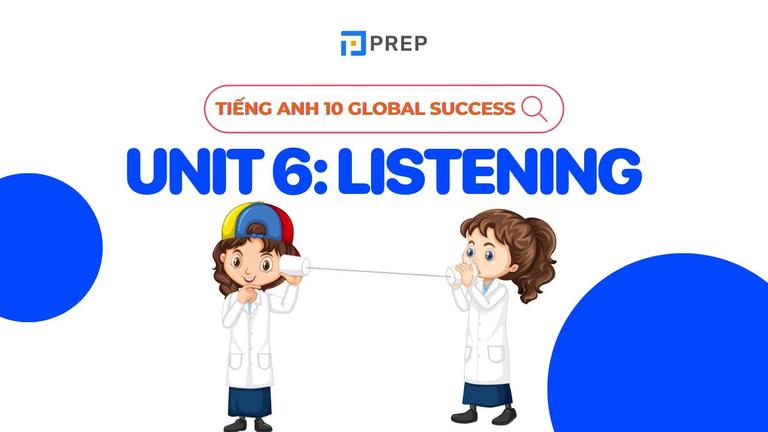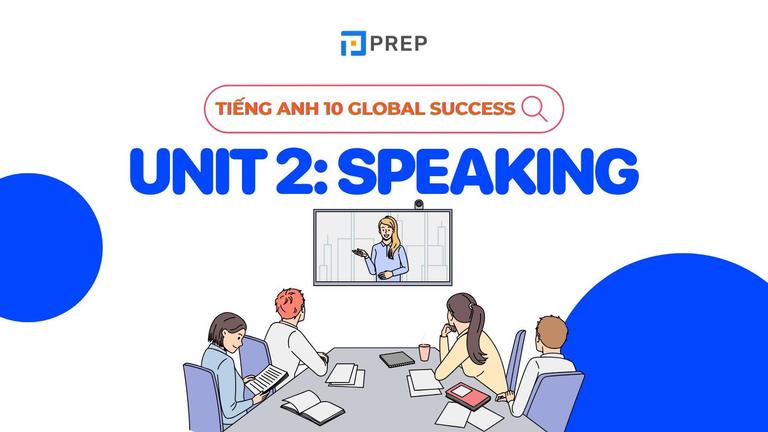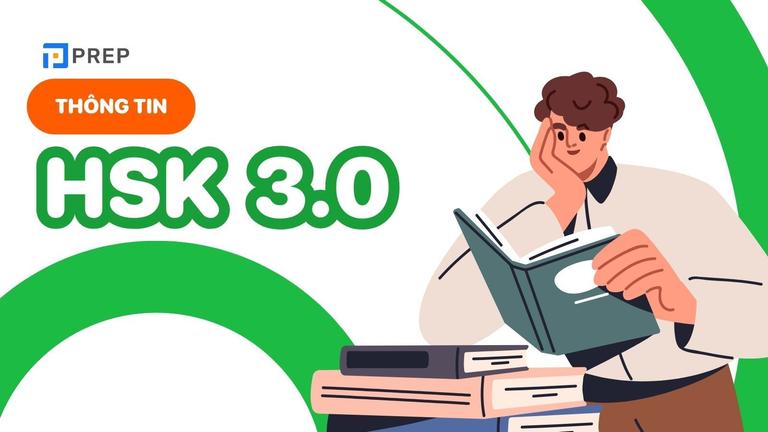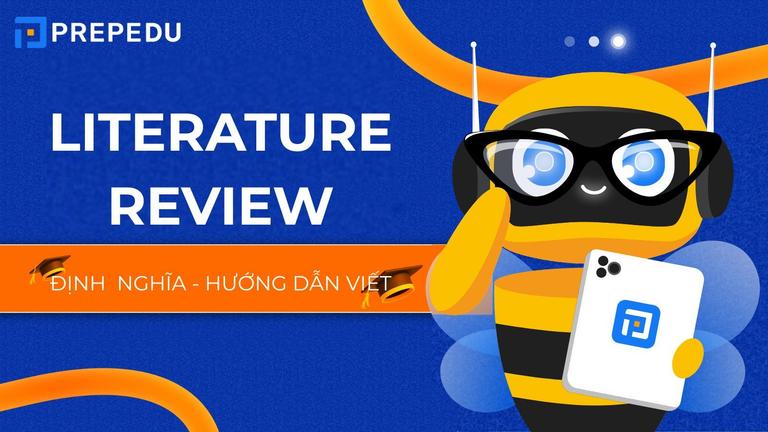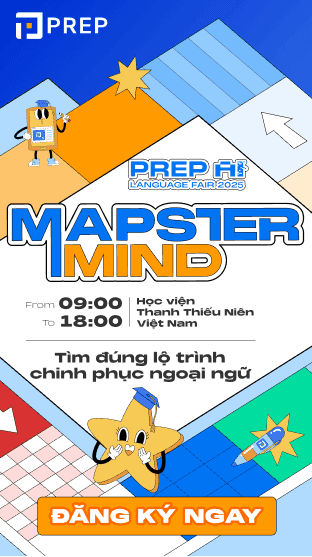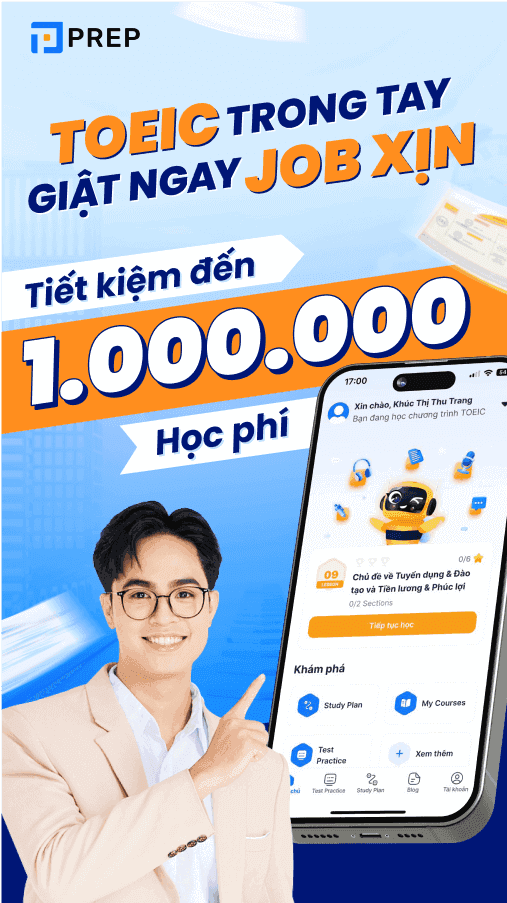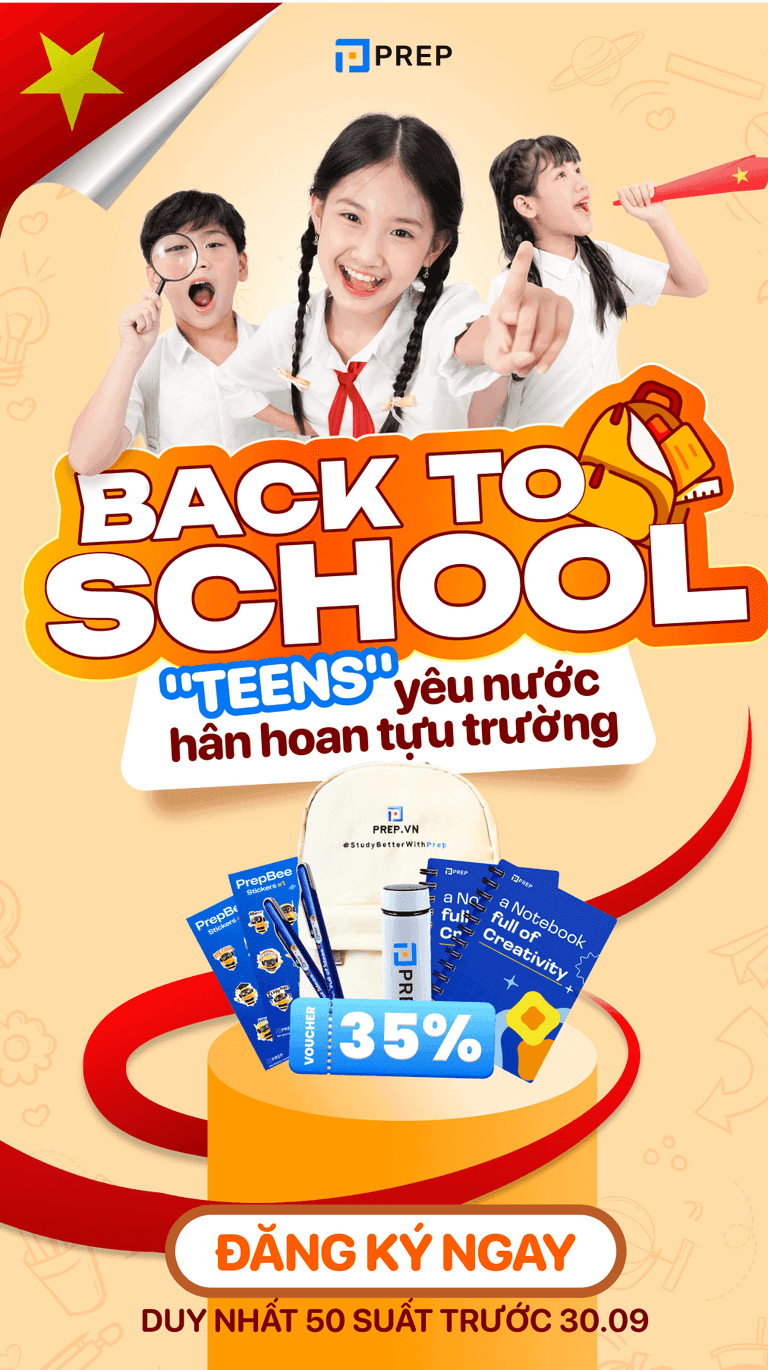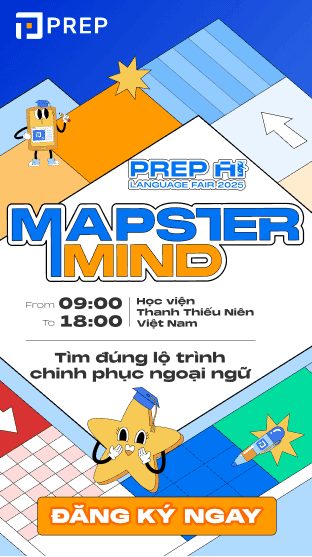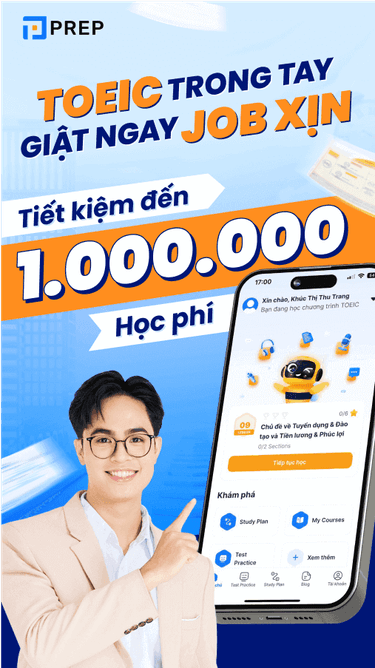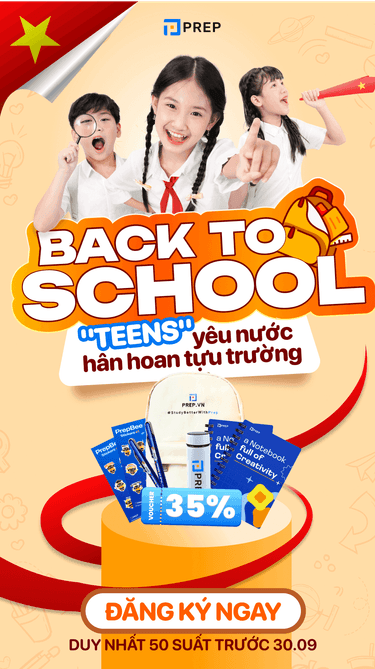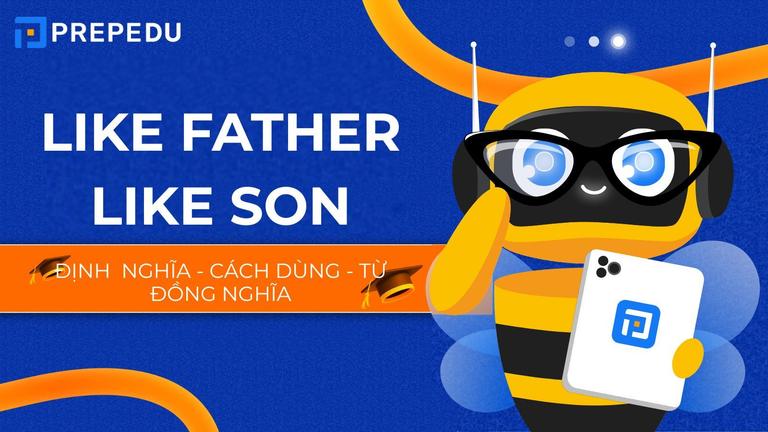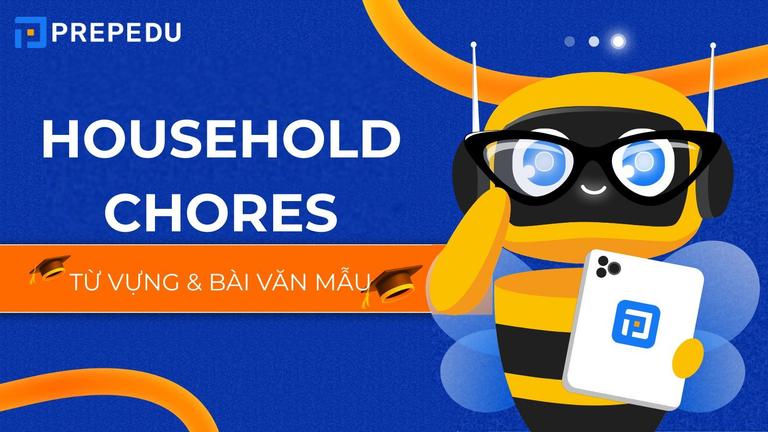Tiếng Anh 12 Unit 7: The World of Mass Media - Lời giải đầy đủ và chi tiết
Trong thời đại số hóa hiện nay, truyền thông đại chúng đóng vai trò quan trọng trong việc định hình thông tin và ảnh hưởng đến cuộc sống hàng ngày của chúng ta. Tiếng Anh 12 Unit 7 "The World of Mass Media" trong sách giáo khoa Global Success không chỉ giúp học sinh nắm vững kiến thức về chủ đề truyền thông mà còn phát triển toàn diện bốn kỹ năng ngôn ngữ. Bài viết này của PREP sẽ trở thành cẩm nang toàn diện, cung cấp lời giải chi tiết, bản dịch chính xác, transcript đầy đủ và các bài mẫu chuẩn để hỗ trợ quá trình học tập hiệu quả nhất cho các em học sinh. Cùng bắt đầu nhé!
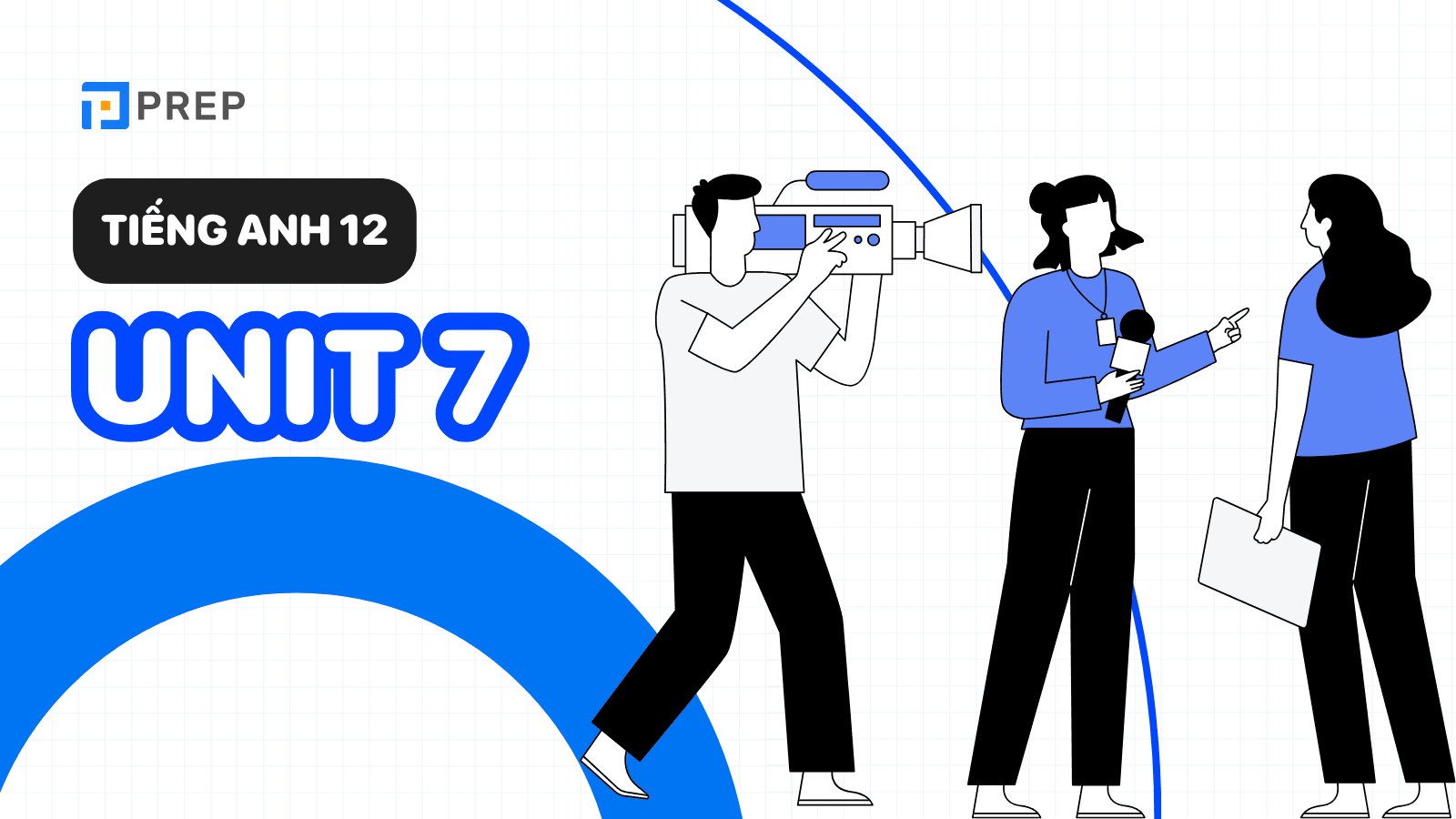
I. Getting Started (Trang 88 - 89)
1. Task 1
Listen and Read.
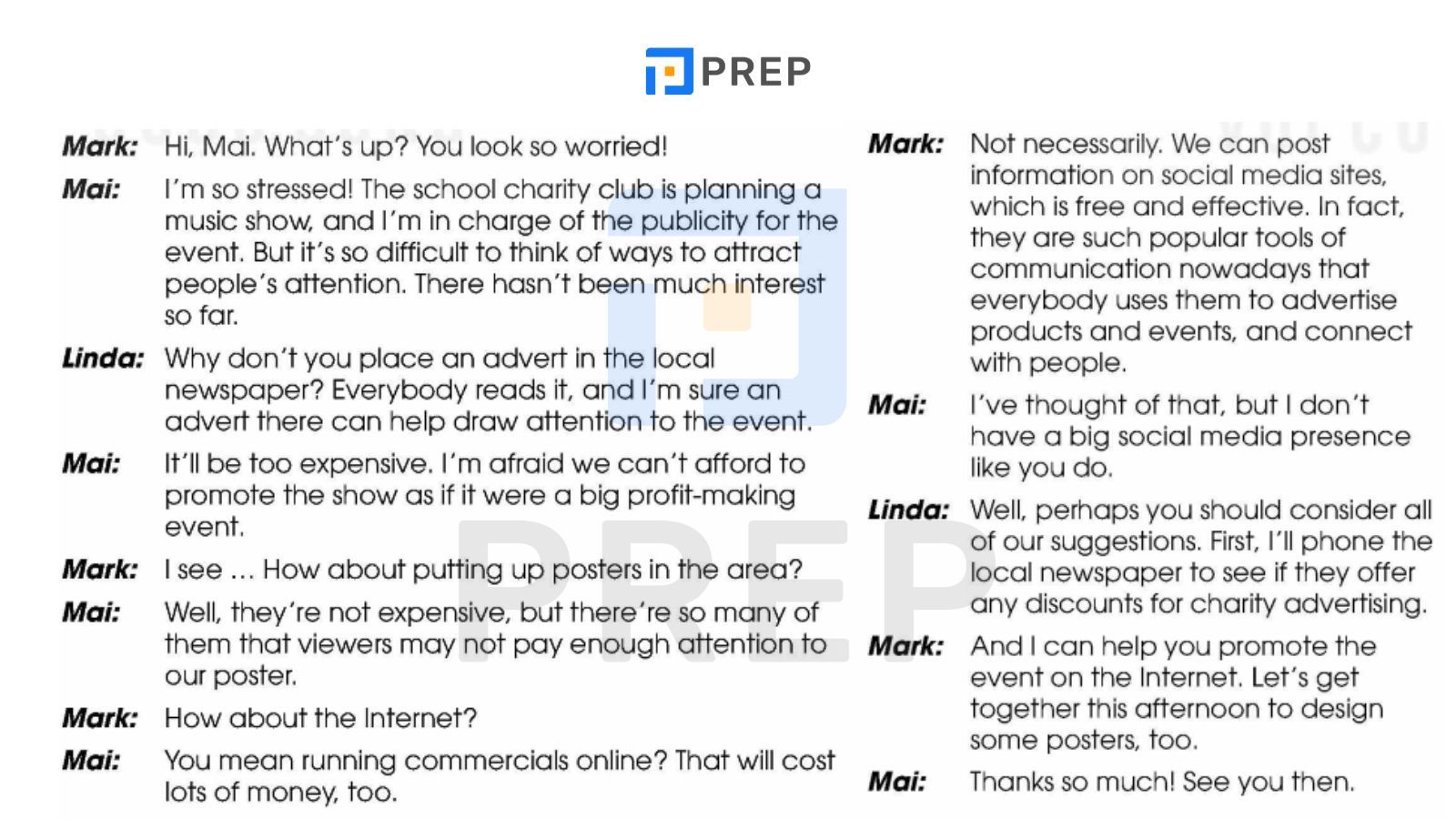
Phần mở đầu của Anh 12 unit 7 đưa chúng ta vào một cuộc thảo luận thực tế về cách quảng bá cho một sự kiện từ thiện, qua đó giới thiệu các loại hình truyền thông khác nhau.
Bản dịch hội thoại:
Mark: Chào Mai. Có chuyện gì vậy? Trông cậu có vẻ lo lắng lắm!
Mai: Tớ đang rất căng thẳng! Câu lạc bộ từ thiện của trường đang lên kế hoạch tổ chức một buổi biểu diễn âm nhạc, và tớ phụ trách phần quảng bá cho sự kiện này. Nhưng thật khó để nghĩ ra cách nào để thu hút sự chú ý của mọi người. Cho đến giờ thì chưa có nhiều người quan tâm.
Linda: Sao cậu không đăng quảng cáo trên báo địa phương? Ai cũng đọc báo đó, và tớ chắc chắn một mẩu quảng cáo trên đó sẽ giúp thu hút sự chú ý đến sự kiện.
Mai: Như thế sẽ tốn kém lắm. Tớ sợ chúng mình không đủ kinh phí để quảng bá chương trình như một sự kiện kiếm lời lớn.
Mark: Tớ hiểu rồi... Thế còn dán áp phích xung quanh khu vực thì sao?
Mai: Ừm, cách đó thì không tốn nhiều tiền, nhưng có quá nhiều áp phích ngoài kia rồi nên người ta có thể sẽ chẳng để ý đến áp phích của tụi mình.
Mark: Vậy còn dùng Internet thì sao?
Mai: Ý cậu là chạy quảng cáo trực tuyến à? Như vậy cũng sẽ tốn nhiều tiền lắm.
Mark: Không nhất thiết đâu. Mình có thể đăng thông tin lên các trang mạng xã hội – vừa miễn phí vừa hiệu quả. Thực tế thì mạng xã hội là công cụ giao tiếp phổ biến đến mức ai cũng dùng nó để quảng bá sản phẩm, sự kiện, và kết nối với người khác.
Mai: Tớ cũng từng nghĩ đến rồi, nhưng tớ không có lượng người theo dõi trên mạng xã hội nhiều như cậu.
Linda: Vậy có lẽ cậu nên cân nhắc tất cả các gợi ý của bọn tớ. Trước hết, tớ sẽ gọi điện cho tòa soạn báo địa phương xem họ có giảm giá cho quảng cáo từ thiện không nhé.
Mark: Còn tớ sẽ giúp cậu quảng bá sự kiện trên Internet. Tụi mình gặp nhau chiều nay để cùng thiết kế vài tấm áp phích nữa nhé.
Mai: Cảm ơn các cậu nhiều! Hẹn gặp chiều nay nhé.
2. Task 2
Read the conversation again and circle the correct answers.
1. Advertising in the local newspaper is expensive, but it will attract people's attention.
➨ Bằng chứng: Mai trả lời Mark: "It'll be too expensive." và Linda nói rằng “Everybody reads it, and I'm sure an advert there can help draw attention to the event.”
2. Posters are not expensive but people may not notice them.
➨ Bằng chứng: Mai nói: "Well, they're not expensive, but there're so many of them that viewers may not pay enough attention to our poster."
3. Posting information on social media sites is a very popular way of promoting things.
➨ Bằng chứng: Mark nhận xét: "...they are such popular tools of communication nowadays..."
4. Mark will help Mai with promoting the event on the Internet.
➨ Bằng chứng: Mark đề nghị: "And I can help you promote the event on the Internet."
3. Task 3
Find words in 1 with the following meanings.
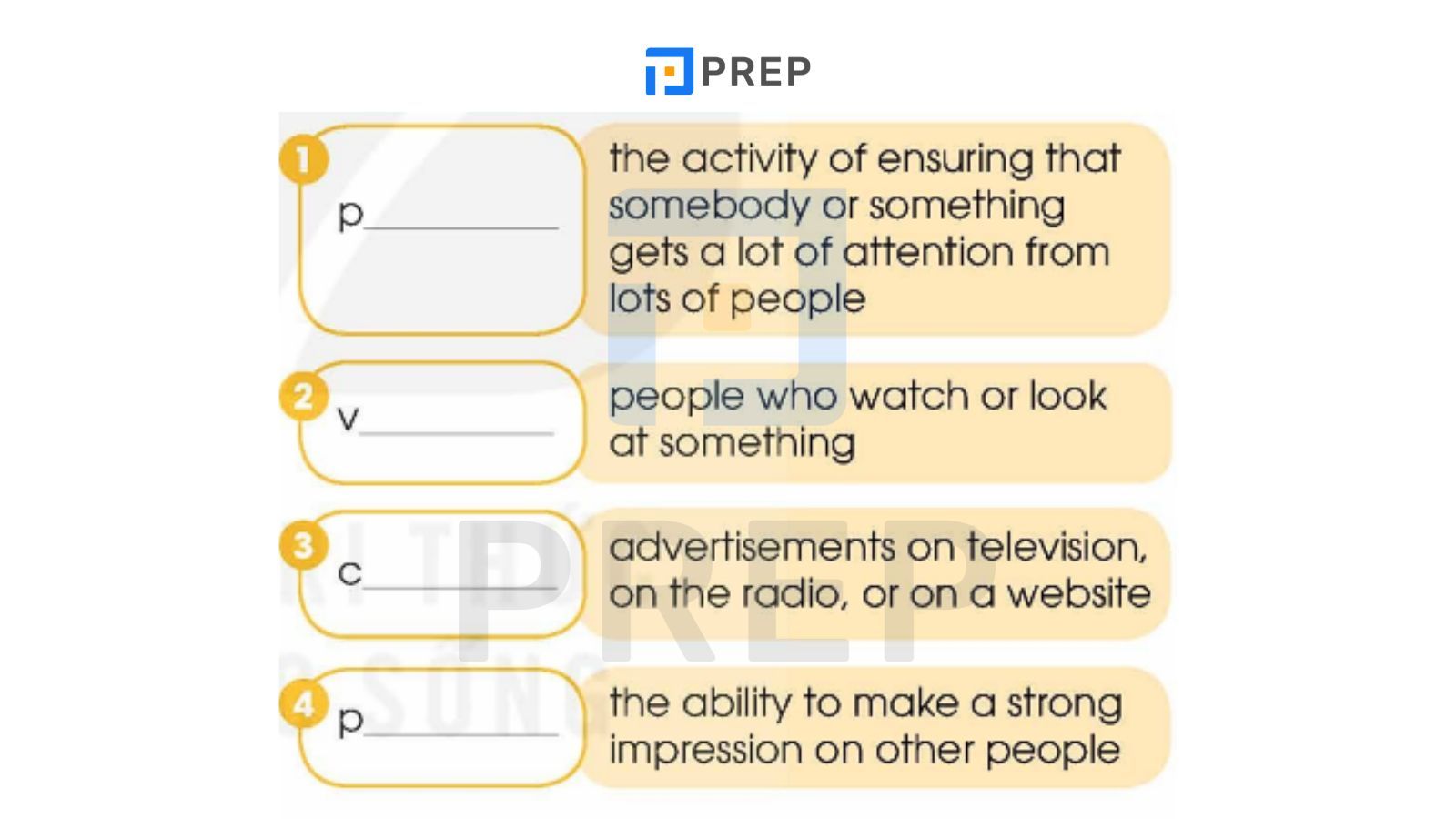
1. Publicity
➨ Giải thích: Mai nói “I’m in charge of the publicity for the event”.
2. Viewers
➨ Giải thích: Mai nói “viewers may not pay enough attention to our poster”.
3. Commercials
➨ Giải thích: Mai nói “running commercials online? That will cost lots of money, too.”
4. Presence
➨ Giải thích: Mai nói “I don’t have a big social media presence like you do.”
4. Task 4
Match the two clauses to make sentences used in 1.
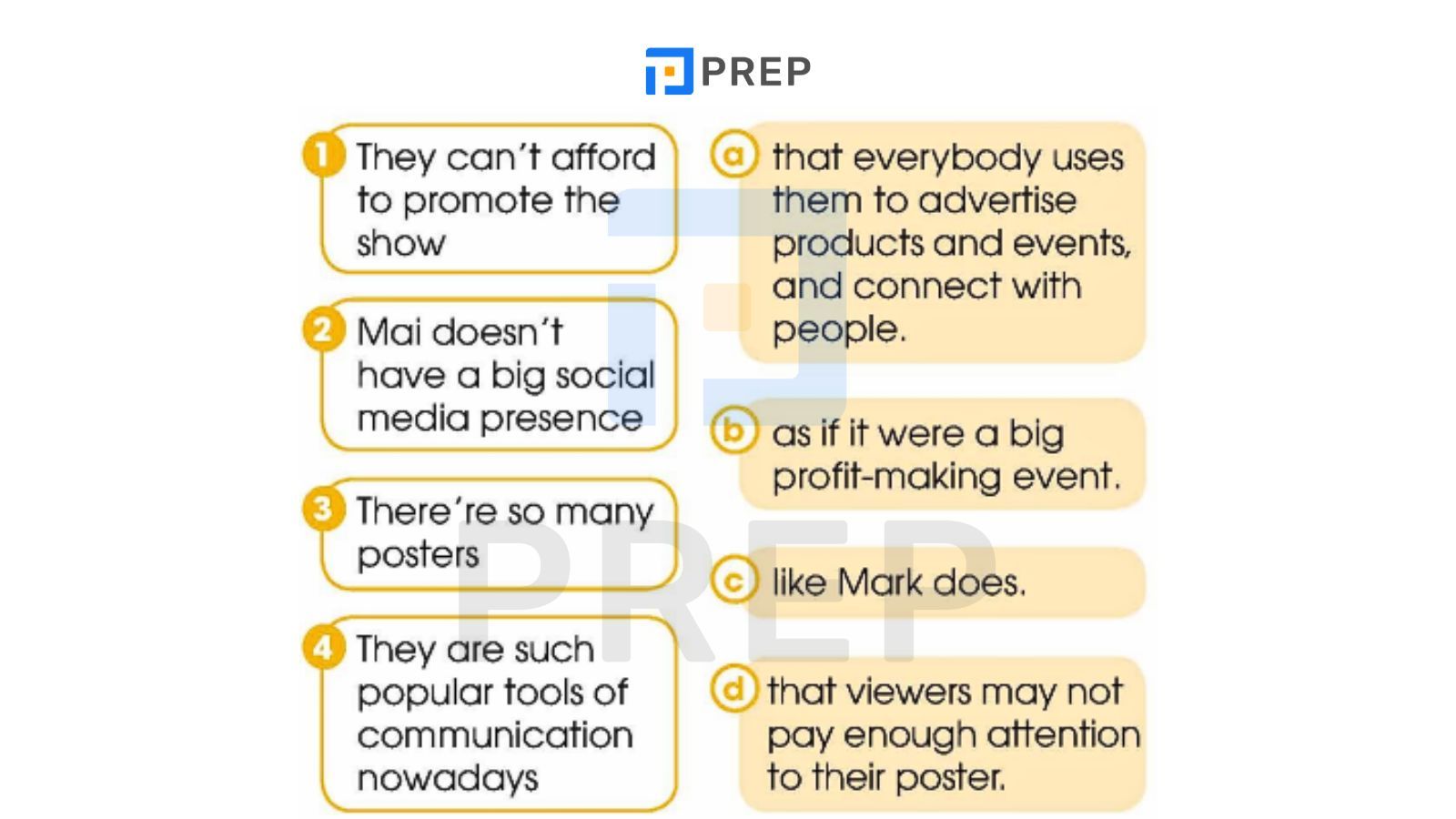
Đáp án:
1 – B: They can’t afford to promote the show → as if it were a big profit-making event.
2 – C: Mai doesn’t have a big social media presence → like Mark does.
3 – D: There’re so many posters → that viewers may not pay enough attention to their poster.
4 – A: They are such popular tools of communication nowadays → that everybody uses them to advertise products and events, and connect with people.
II. Language (Trang 90 - 91)
1. Pronunciation - Linking /r/ between two vowels
1.1. Task 1
Listen and repeat. Pay attention to the linking /r/. Then practise saying the sentences in pairs.
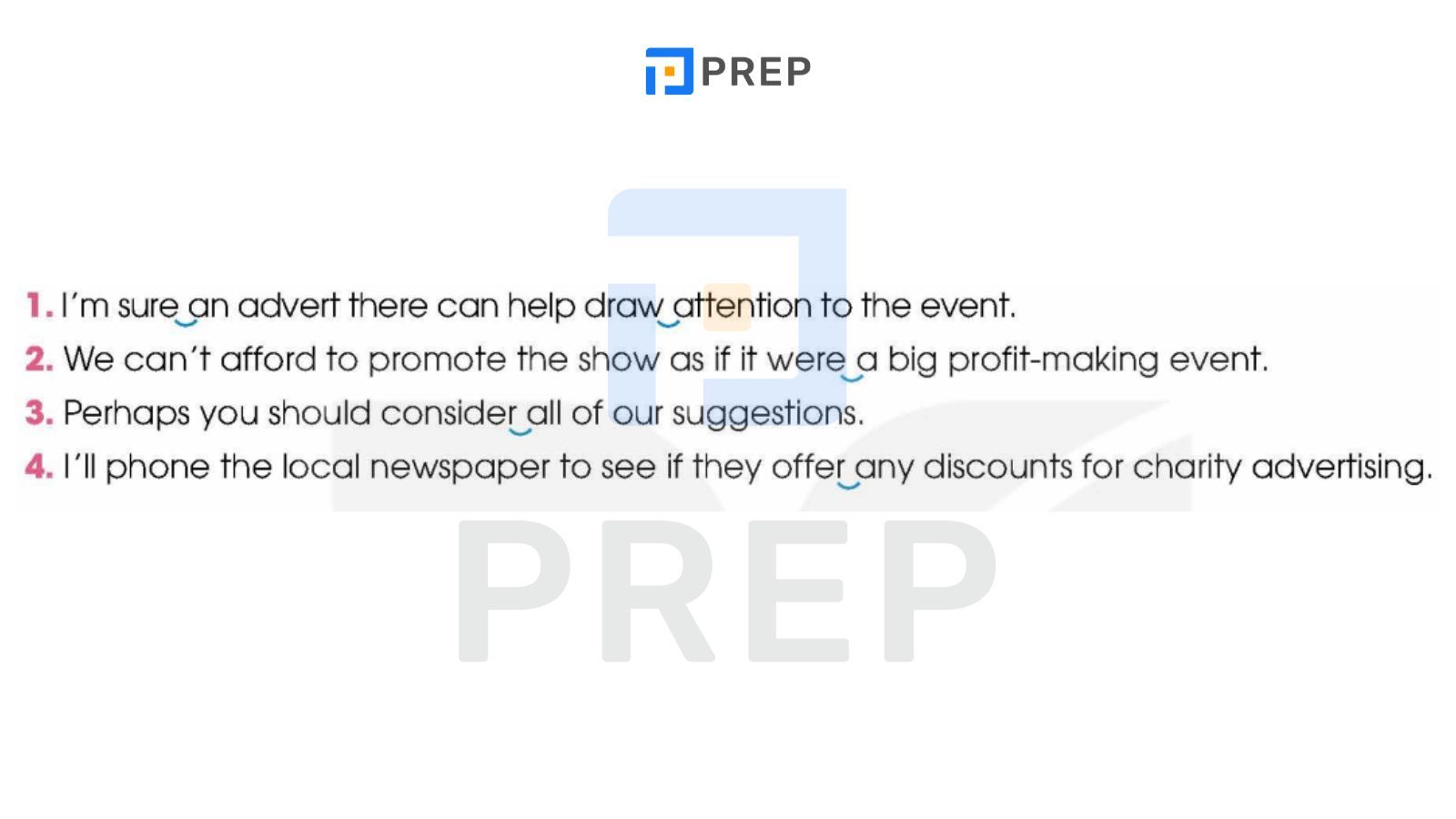
1.2. Task 2
Mark (ᴗ) the places where the linking /r/ can appear. Listen and check. Then practise saying the sentences.
1. I saw ‿ an interesting advert about the charity event.
2. Traditional mass media, for‿example, TV and newspapers, are still popular.
3. There ‿ are more ‿ adverts on TV nowadays.
4. There ‿ is a law‿against sharing private photos without permission.
2. Vocabulary
2.1. Task 1
Match each word (1-5) with its meaning (a-e).
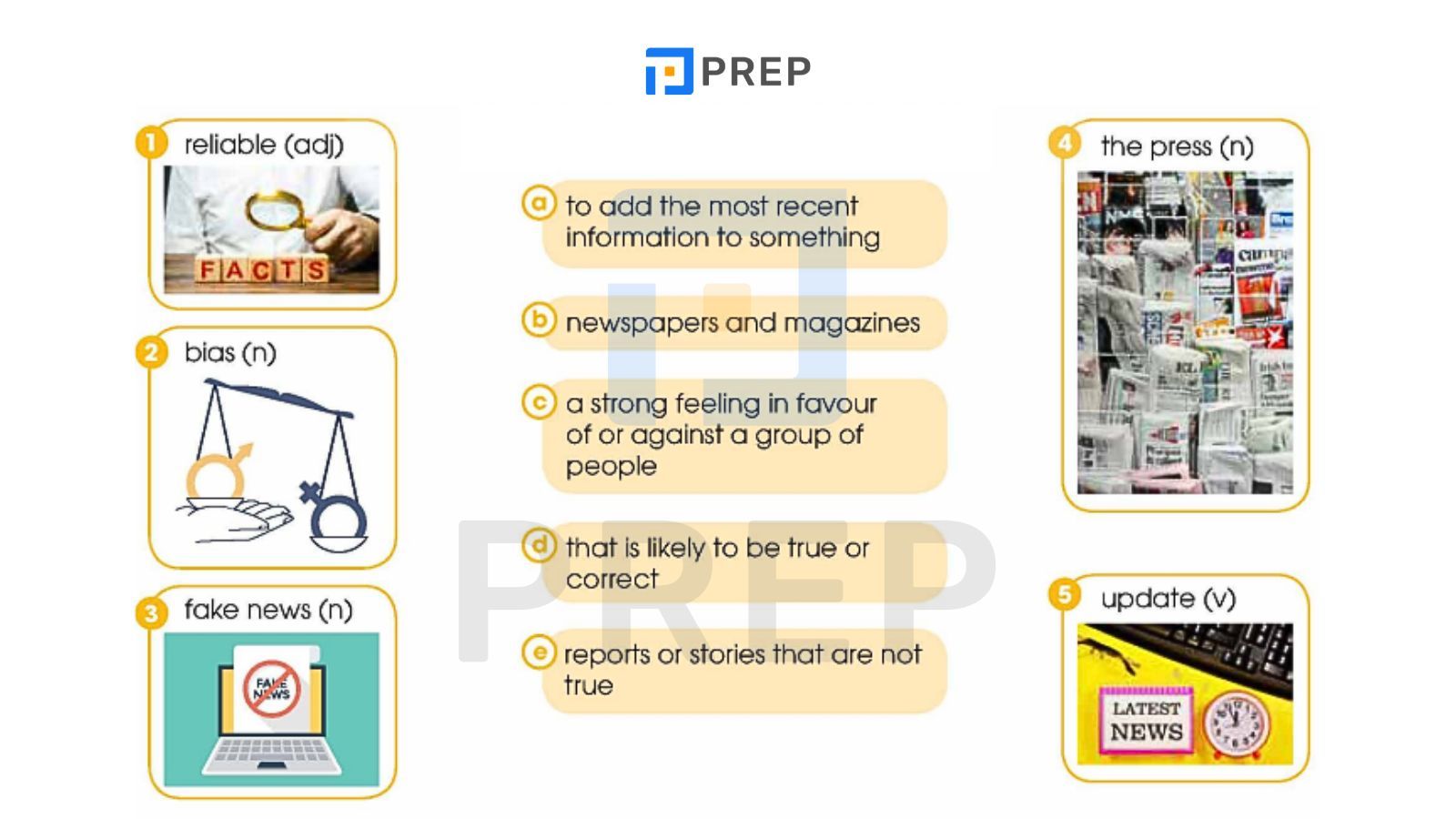
-
reliable (adj) → d that is likely to be true or correct
-
bias (n) → c a strong feeling in favour of or against a group of people
-
fake news (n) → e reports or stories that are not true
-
the press (n) → b newspapers and magazines
-
update (v) → a to add the most recent information to something
Giải thích:
-
Reliable = đáng tin cậy → cái gì đó có khả năng đúng sự thật.
-
Bias = thiên vị, có cảm xúc nghiêng về hoặc chống lại nhóm nào đó.
-
Fake news = tin giả, không đúng sự thật.
-
The press = báo chí, bao gồm cả báo và tạp chí.
-
Update = cập nhật thông tin mới nhất.
2.2. Task 2
Complete the following text using the correct forms of the words in 1.
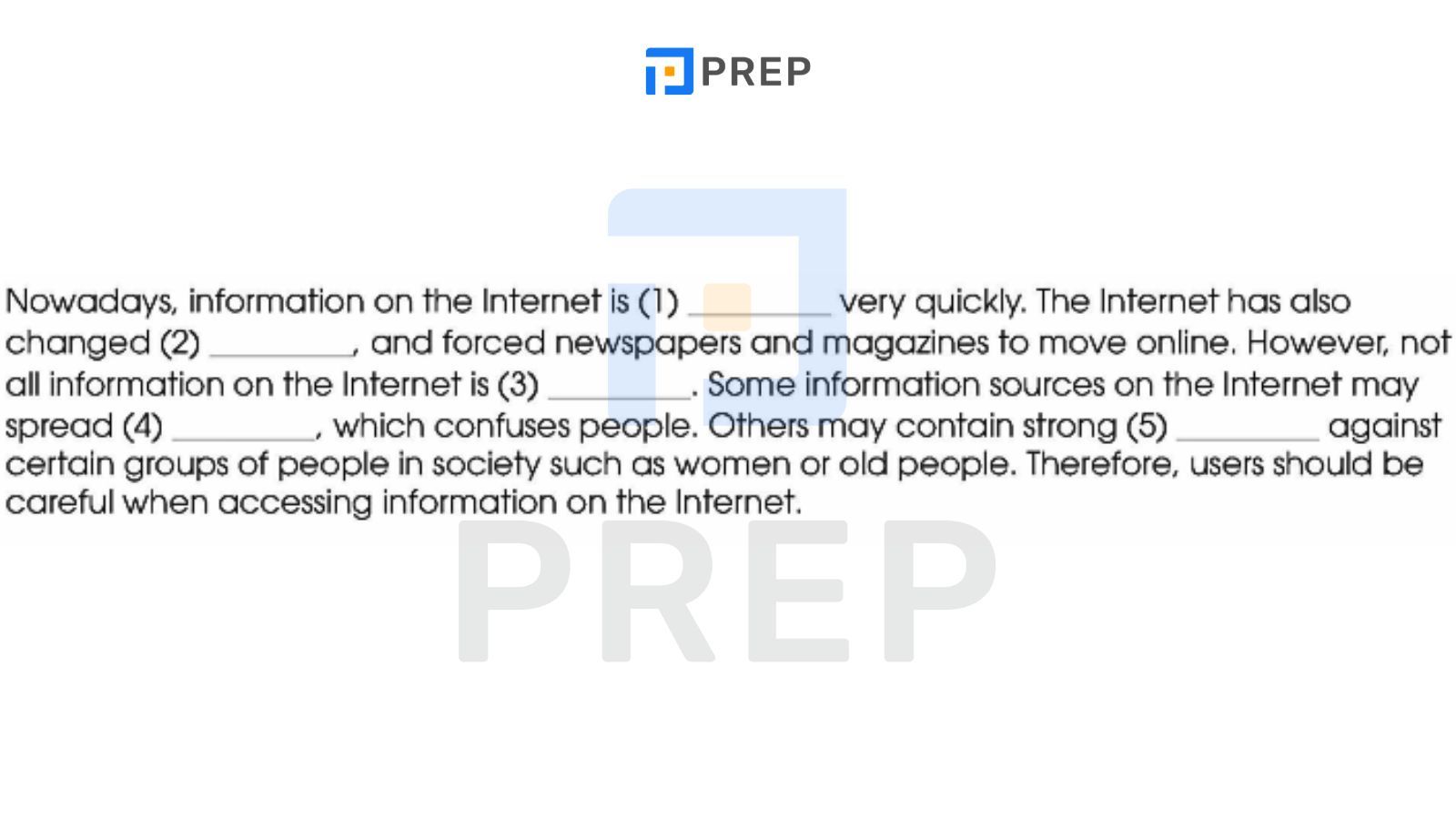
1. updated → động từ ở dạng bị động: “is updated very quickly” (được cập nhật rất nhanh).
2. the press → danh từ chỉ báo chí, dùng sau động từ “changed”.
3. reliable → tính từ mô tả “information”.
4. fake news → danh từ số nhiều, đóng vai trò tân ngữ cho động từ “spread”.
5. bias → danh từ chỉ sự thiên vị, ở đây làm tân ngữ cho “contain”.
3. Grammar
3.1. Task 1
Combine the sentences using suitable adverbial clauses.
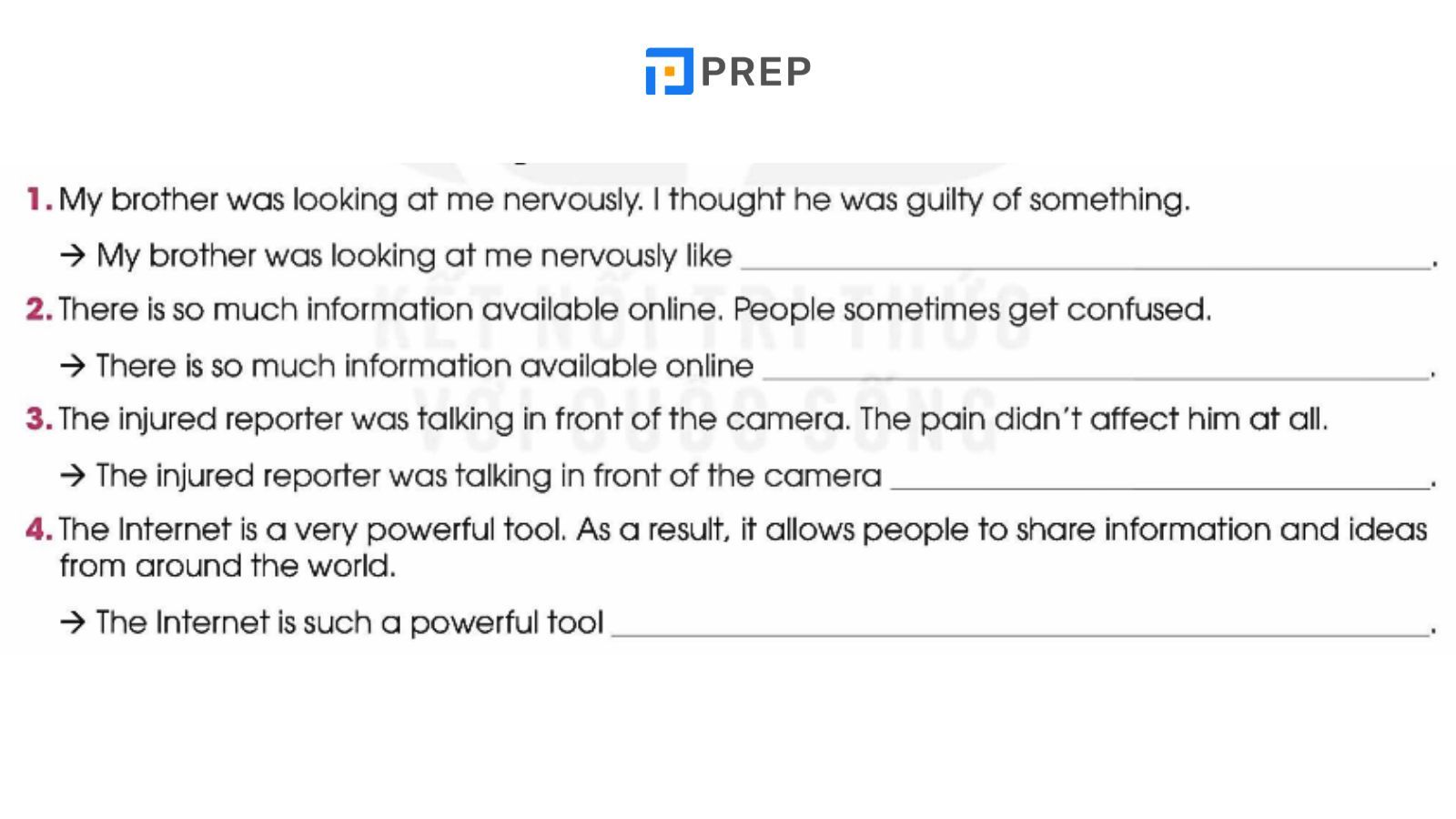
-
My brother was looking at me nervously like he was guilty of something.
-
There is so much information available online that people sometimes get confused.
-
The injured reporter was talking in front of the camera as if the pain didn’t affect him at all.
-
The Internet is such a powerful tool that it allows people to share information and ideas from around the world.
Giải thích ngắn gọn:
-
as if = như thể → dùng để nối khi mô tả trạng thái tưởng tượng hoặc ấn tượng.
-
that → dùng với so/such... that để nói về kết quả.
3.2. Task 2
Work in pairs. Talk about a type of mass media you use in your everyday life, using adverbial clauses of manner and result.
Bài mẫu tham khảo:
I love reading news on social media as if I were a journalist myself, so I follow many news pages on Facebook and X (formerly Twitter). The news updates so fast that I can catch up with current events even before they appear on TV. I also comment and share posts as if I were participating in a real debate. Social media has become such a convenient tool that I use it every day to get information.
III. Reading (Trang 92 - 93)
Bài đọc trong Unit 7 lớp 12 sách mới với tiêu đề "Digital media vs. traditional media".
1. Task 1
Work in pairs. Read the first section of the article. Discuss the following questions.
Do you think that digital media can replace traditional media? Why/Why not?
Trả lời mẫu:
Yes, I believe digital media can replace traditional media to a large extent because it is more accessible, interactive, and flexible. People can get updates instantly, and almost every organization can communicate with its audience directly. However, traditional media still plays an important role in areas where Internet access is limited or unreliable, and it provides more fact-checked information.
2. Task 2
Read the article. Match the highlighted words with their meanings.
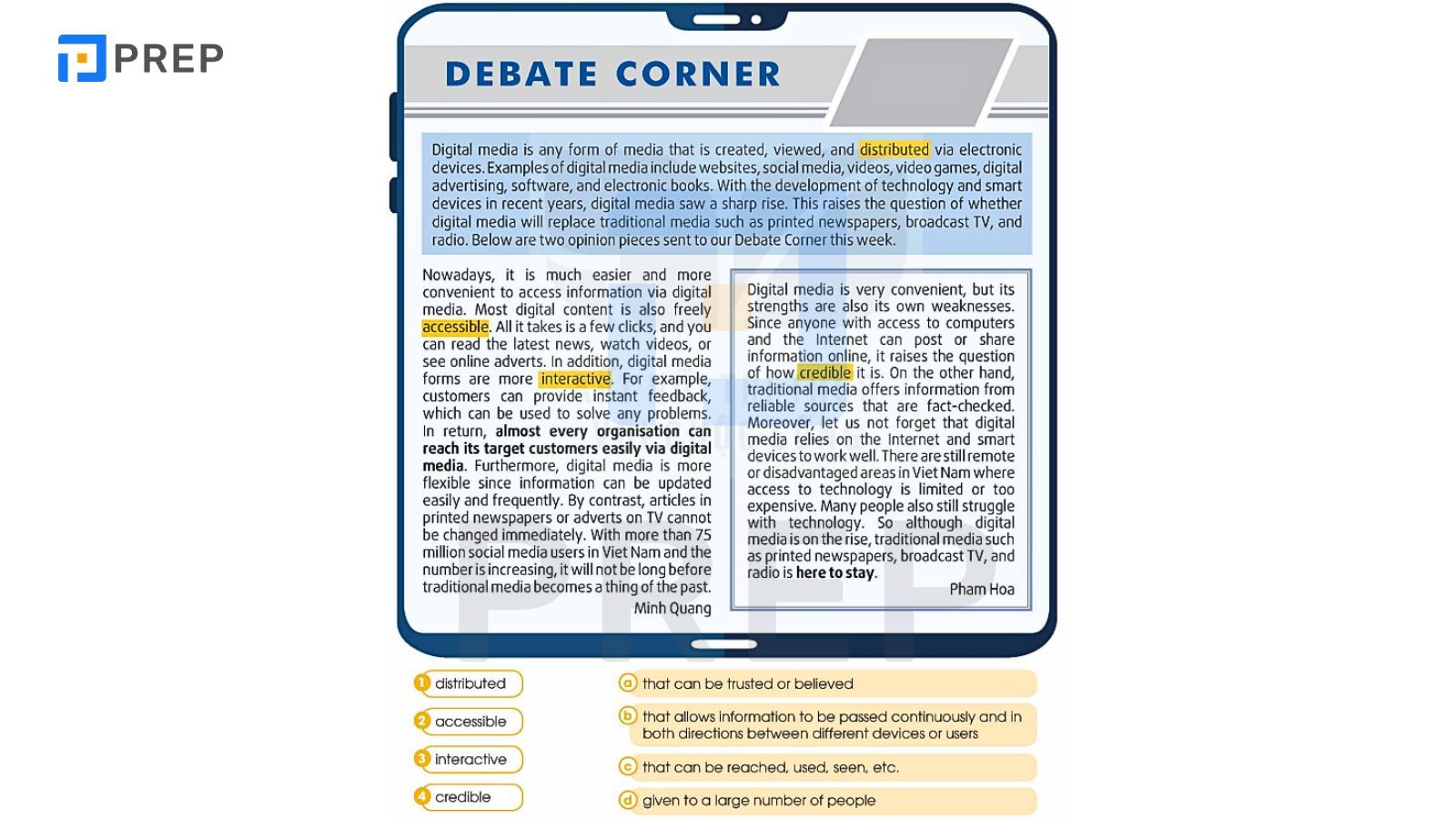
|
Từ vựng |
Nghĩa phù hợp |
|
1. distributed |
e. given to a large number of people |
|
2. accessible |
c. that can be reached, used, seen, etc. |
|
3. interactive |
b. that allows information to be passed continuously and in both directions between different devices or users |
|
4. credible |
a. that can be trusted or believed |
Giải thích từ vựng:
-
distributed: phân phối, truyền đến nhiều người.
-
accessible: có thể tiếp cận được.
-
interactive: có tính tương tác, giao tiếp hai chiều.
-
credible: đáng tin cậy, có thể tin được.
Bài dịch:
Góc tranh luận
Phương tiện truyền thông kỹ thuật số là bất kỳ hình thức truyền thông nào được tạo ra, xem và phân phối thông qua các thiết bị điện tử. Ví dụ bao gồm: website, mạng xã hội, video, trò chơi điện tử, quảng cáo kỹ thuật số, phần mềm và sách điện tử. Với sự phát triển của công nghệ và các thiết bị thông minh trong những năm gần đây, truyền thông kỹ thuật số đã tăng trưởng mạnh mẽ. Điều này đặt ra câu hỏi liệu truyền thông kỹ thuật số có thay thế được các phương tiện truyền thống như báo in, truyền hình phát sóng và radio hay không. Dưới đây là hai ý kiến gửi về Góc tranh luận tuần này.
Minh Quang viết:
Ngày nay, việc tiếp cận thông tin qua phương tiện kỹ thuật số trở nên dễ dàng và thuận tiện hơn rất nhiều. Hầu hết nội dung kỹ thuật số cũng có thể truy cập miễn phí. Chỉ cần vài cú nhấp chuột là bạn có thể đọc tin tức mới nhất, xem video hoặc quảng cáo trực tuyến. Ngoài ra, các hình thức truyền thông kỹ thuật số còn có tính tương tác cao. Ví dụ, khách hàng có thể phản hồi ngay lập tức, điều này giúp giải quyết các vấn đề. Đổi lại, hầu như mọi tổ chức đều có thể tiếp cận khách hàng mục tiêu dễ dàng qua truyền thông kỹ thuật số.
Hơn nữa, phương tiện kỹ thuật số linh hoạt hơn vì thông tin có thể được cập nhật dễ dàng và thường xuyên. Ngược lại, bài báo in hoặc quảng cáo trên TV không thể thay đổi ngay lập tức. Với hơn 75 triệu người dùng mạng xã hội tại Việt Nam và con số đang tăng lên, sẽ không lâu nữa truyền thông truyền thống trở thành quá khứ.
Pham Hoa viết:
Truyền thông kỹ thuật số rất tiện lợi, nhưng điểm mạnh của nó cũng là điểm yếu. Vì bất cứ ai có máy tính và Internet đều có thể đăng hoặc chia sẻ thông tin trực tuyến, điều này đặt ra câu hỏi về độ đáng tin cậy của nó. Ngược lại, truyền thông truyền thống cung cấp thông tin từ các nguồn đáng tin cậy và đã được kiểm chứng.
Ngoài ra, đừng quên rằng truyền thông kỹ thuật số phụ thuộc vào Internet và thiết bị thông minh để hoạt động tốt. Ở Việt Nam vẫn còn nhiều khu vực xa xôi hoặc khó khăn mà việc tiếp cận công nghệ còn hạn chế hoặc quá đắt đỏ. Nhiều người vẫn gặp khó khăn khi sử dụng công nghệ. Vì vậy, mặc dù truyền thông kỹ thuật số đang phát triển, truyền thông truyền thống như báo in, TV phát sóng và radio vẫn sẽ tồn tại.
3. Task 3
Read the article again. Write Q next to Quang's opinion, H next to Hoa's opinion, and N if it is not their opinion.
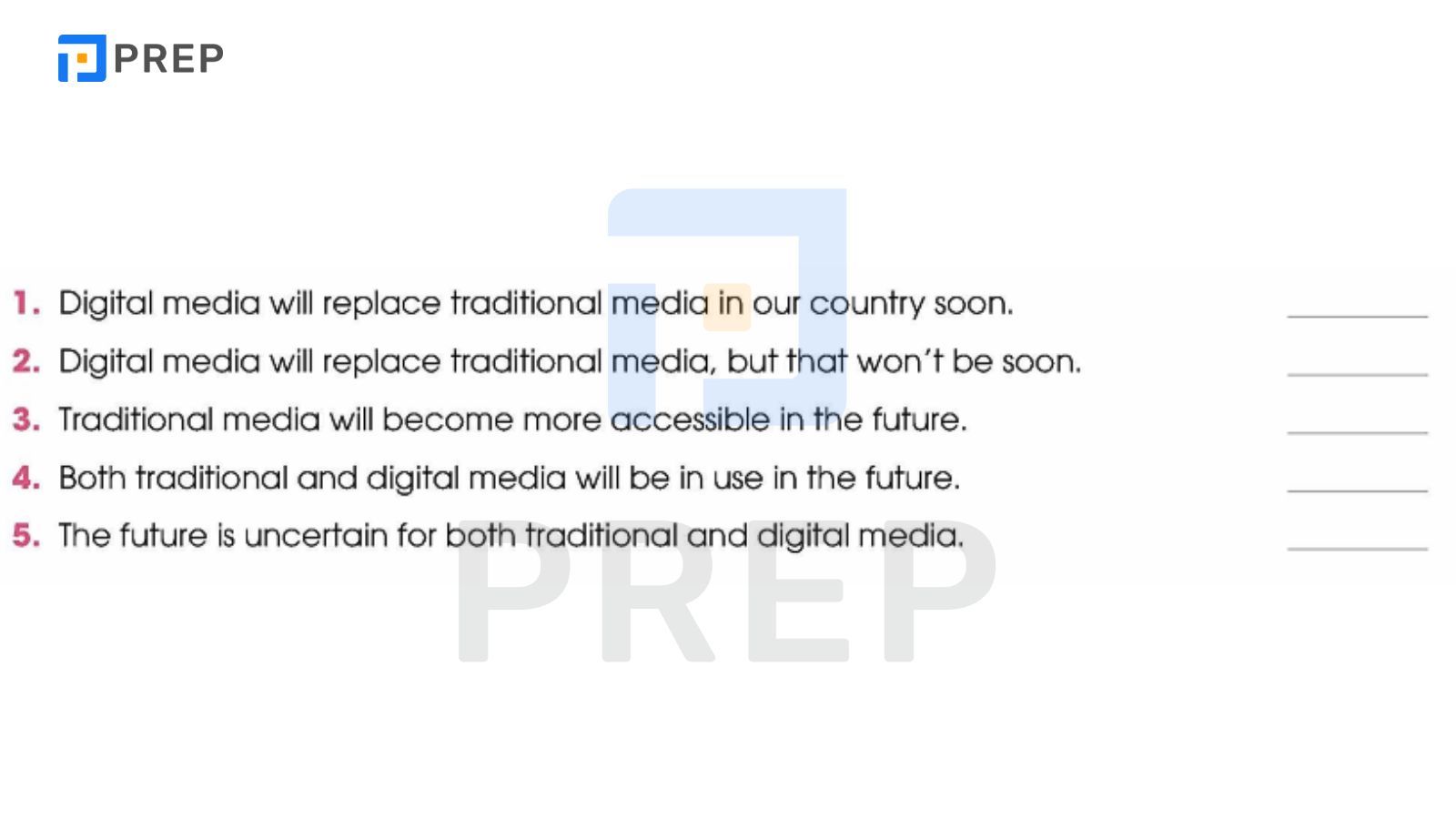
|
Câu |
Nội dung |
Đáp án |
Giải thích |
|
1 |
Digital media will replace traditional media in our country soon. |
Q |
Quang nói "it will not be long before traditional media becomes a thing of the past." |
|
2 |
Digital media will replace traditional media, but that won’t be soon. |
N |
|
|
3 |
Traditional media will become more accessible in the future. |
N |
Không ai đề cập rõ về việc phương tiện truyền thống sẽ dễ tiếp cận hơn trong tương lai. |
|
4 |
Both traditional and digital media will be in use in the future. |
H |
Hoa kết luận rằng cả hai loại hình truyền thông sẽ tiếp tục tồn tại song song. |
|
5 |
The future is uncertain for both traditional and digital media. |
N |
Không ai nói tương lai là không chắc chắn – mỗi người có quan điểm rõ ràng. |
4. Task 4
Read the article again. Choose the correct answers.
Đáp án:
1. B, C, D
➨ Giải thích: Quang nhấn mạnh tính dễ truy cập, cập nhật liên tục và tương tác hai chiều.
2. C
➨ Giải thích: Bài viết có đề cập “For example, customers can provide instant feedback, which can be used to solve any problems. In return, almost every organisation can reach its target customers easily via digital media.”
3. A, C, D
➨ Giải thích: Hoa nêu ba nhược điểm chính của digital media: thiếu độ tin cậy, giới hạn công nghệ ở vùng sâu vùng xa và kỹ năng công nghệ của người dân.
4. B
➨ Giải thích: Cụm “radio is here to stay” cho thấy Hoa tin rằng truyền thông truyền thống vẫn giữ vai trò quan trọng.
5. Task 5
Work in pairs. Discuss the following questions.
After reading the article, who do you agree with, Hoa or Quang? Why?
Gợi ý câu trả lời mẫu:
I agree with Hoa because not everyone has easy access to digital media. Many areas still lack stable Internet connections, and some people find technology difficult to use. Also, traditional media like printed newspapers and TV are more credible because they are fact-checked before publication. Therefore, traditional media will continue to play an important role, even though digital media is growing.
IV. Speaking (Trang 94)
Phần Speaking của tiếng Anh 12 Unit 7 được thiết kế để phát triển kỹ năng thảo luận và so sánh các phương tiện truyền thông khác nhau.
1. Task 1
Work in pairs. Discuss the different types of mass media. Make notes in the table below.
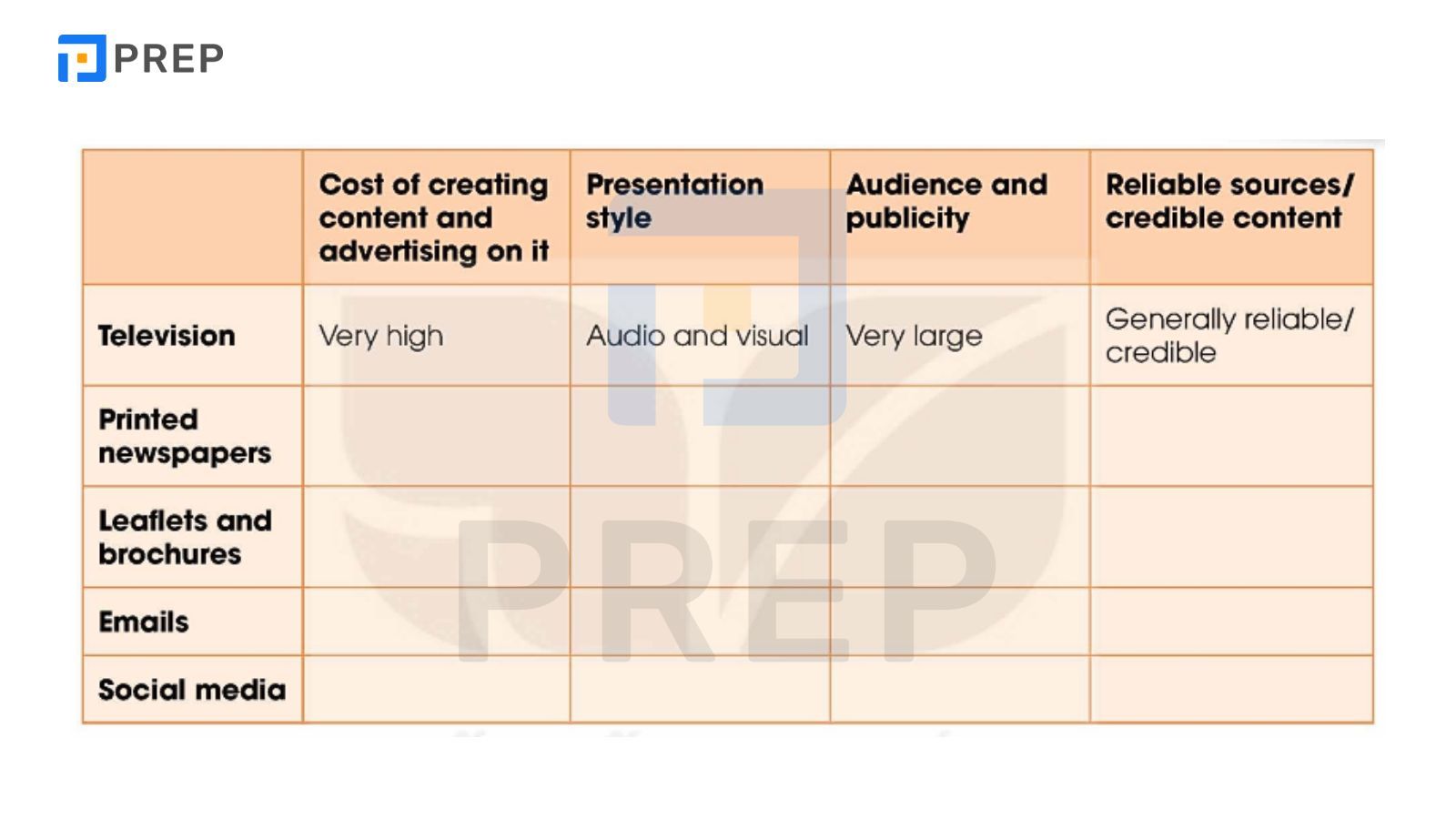
|
Type of Mass Media |
Cost of creating content and advertising on it |
Presentation style |
Audience and publicity |
Reliable sources / credible content |
|
Television |
Very high |
Audio and visual |
Very large |
Generally reliable / credible |
|
Printed newspapers |
High |
Text and images |
Large |
Reliable and fact-checked |
|
Leaflets and brochures |
Medium |
Printed images and text |
Small to medium |
Depends on source |
|
Emails |
Low |
Text with some visuals |
Small to medium |
May not be seen as credible |
|
Social media |
Low or free |
Visual, audio, interactive |
Very large |
Varies; not always credible |
Giải thích:
-
Social media có thể miễn phí, tiếp cận rộng, nhưng độ tin cậy không cao vì bất kỳ ai cũng có thể đăng thông tin.
-
Email rẻ nhưng thường bị bỏ qua nếu không chuyên nghiệp.
-
Leaflets phù hợp với sự kiện quy mô nhỏ, không đòi hỏi công nghệ cao.
-
TV và báo in tiếp cận rộng nhưng chi phí cao.
2. Task 2
Work in groups. Discuss the following situations and decide on the most suitable type of media to use in each situation. Provide reasons for your choice.
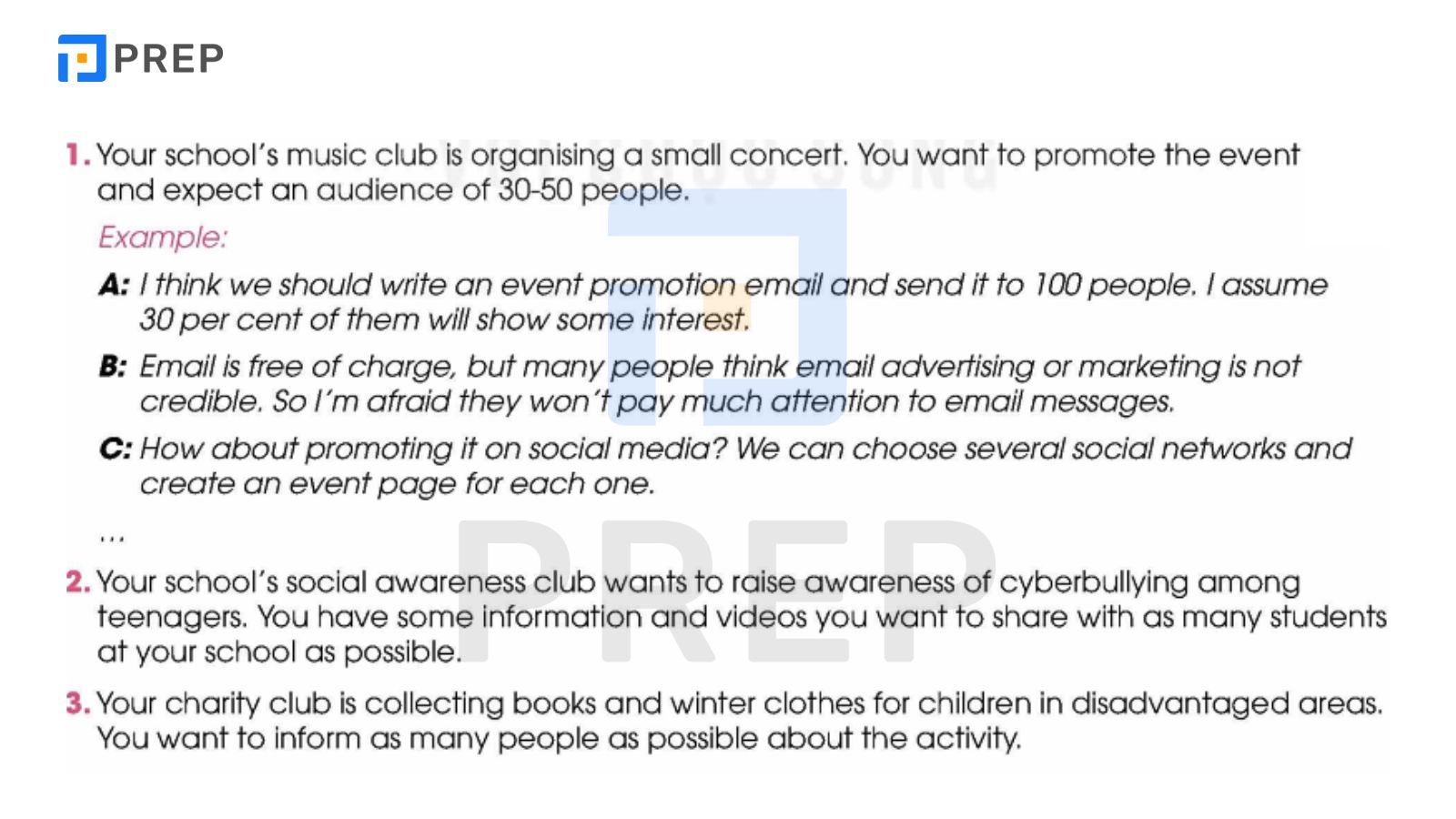
1. Your school's music club is organising a small concert. You want to promote the event and expect an audience of 30-50 people.
➨ Gợi ý: Social media hoặc Emails
-
Social media: miễn phí, có thể tạo sự kiện và mời bạn bè. Hiệu quả nếu khán giả là học sinh/sinh viên có tài khoản mạng xã hội.
-
Email: phù hợp nếu đã có danh sách email sẵn. Tuy nhiên, ít người mở và đọc nếu không nổi bật.
Hội thoại mẫu:
A: We need to promote our school's concert, but our budget is limited. What's the best approach?
B: I think we should forget about TV or newspapers; they are too expensive. Email marketing is a good start. We can design a nice e-flyer and send it to all students and parents. It's free.
C: That's a good idea, but it might not be enough. We should also use social media. We can create a Facebook event page, post teasers and behind-the-scenes photos on Instagram. This will create a buzz and allow people to share the event easily.
A: I agree. So, our strategy is a combination of direct emails for formal announcements and a strong social media campaign for engagement and wider reach. That sounds effective and budget-friendly.
2. Your school's social awareness club wants to raise awareness of cyberbullying among teenagers. You have some information and videos you want to share with as many students at your school as possible.
➨ Gợi ý: Social media + School website or Printed materials
-
Social media: truyền tải video + hình ảnh sinh động, dễ lan tỏa thông điệp đến học sinh.
-
Printed leaflets: phát tại trường, dễ tiếp cận học sinh không dùng mạng.
➨ Lựa chọn đề xuất: Social media
➨ Lý do: Có thể chia sẻ video cảnh báo, infographics, bình luận, tạo chiến dịch tương tác.
Hội thoại mẫu:
Nam: Our social awareness club wants to talk about cyberbullying. What’s the best way?
Linh: I think we should make short videos and post them on social media.
Phong: That would work. Teenagers love videos and visual content.
Linh: Also, we can ask students to comment and share their thoughts online.
Nam: Good idea. It makes them feel involved and helps spread awareness.
✅ Decision: Use social media to share videos and encourage interaction.
3. Your charity club is collecting books and winter clothes for children in disadvantaged areas. You want to inform as many people as possible about the activity.
➨ Gợi ý: Leaflets + Social media + Email
-
Leaflets: phát ở nơi công cộng, lớp học, cộng đồng dân cư.
-
Social media: đăng bài kèm hình ảnh, lời kêu gọi, hashtag.
-
Email: gửi cho giáo viên, phụ huynh hoặc các tổ chức hỗ trợ.
➨ Lựa chọn đề xuất: Kết hợp Leaflets + Social media
➨ Lý do: Truyền thông online lan tỏa nhanh, tờ rơi giúp tiếp cận người không dùng mạng.
Hội thoại mẫu:
Huy: We need to collect books and clothes. How can we let people know?
Mai: I think leaflets would be good. We can hand them out in class and at the school gate.
An: Yes, but we should also post something on social media to reach more people.
Huy: That’s smart! Some people don’t read leaflets, but they’re always on Facebook or Zalo.
✅ Decision: Use both leaflets and social media to reach as many people as possible.
3. Task 3
Report your answers to the whole class. Vote for the best idea for each situation.
Bài mẫu:
For the concert, we decided to use social media because it allows us to create event pages, invite friends, and promote for free.
For raising awareness about cyberbullying, we chose social media again because it’s where teenagers spend most of their time, and we can share videos and visual content.
For the charity campaign, we agreed to use a combination of leaflets and social media. Leaflets will help spread the word at school, and social media can help us reach the wider community.
V. Listening (Trang 95)
Phần Listening của tiếng Anh lớp 12 Unit 7 tập trung vào chủ đề Fake news on the Internet.
1. Task 1
Work in pairs. Find 3 words in the wordsearch to show things you should look at to decide whether a piece of news is fake or not.
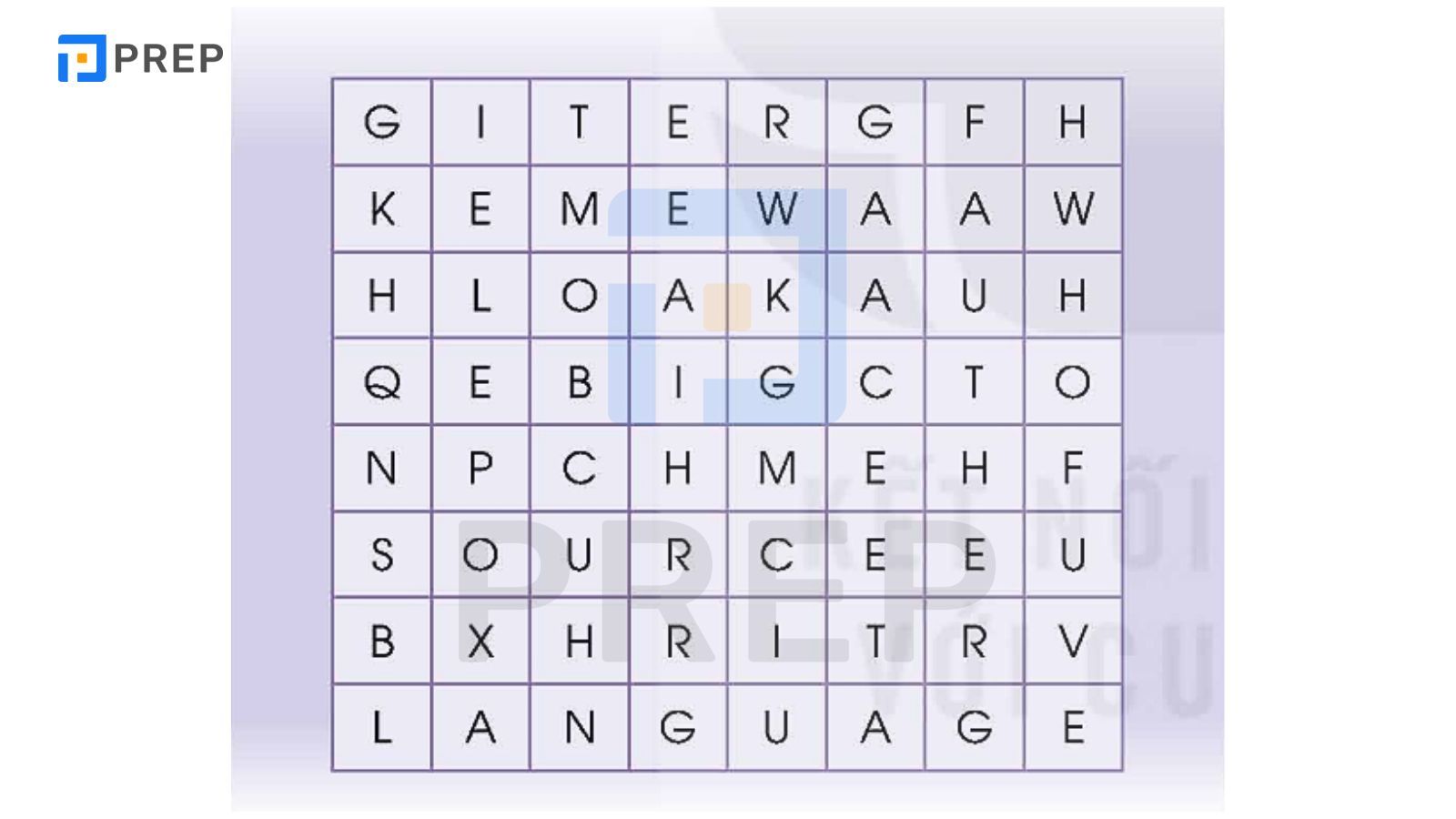
Đáp án:
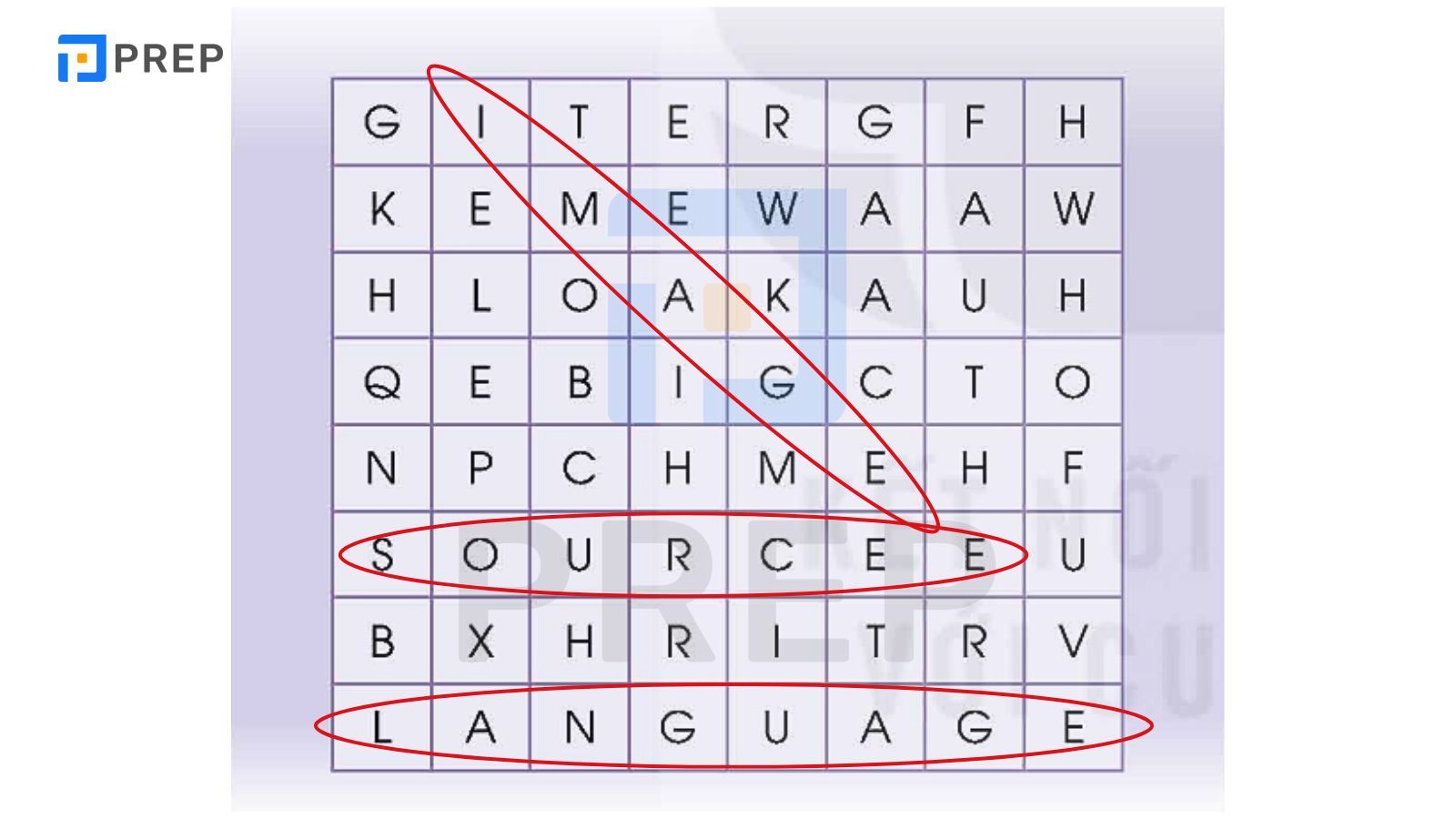
2. Task 2
Listen to three students talking about fake news. Match the speaker with his/her attitude towards fake news. There are TWO extra options.
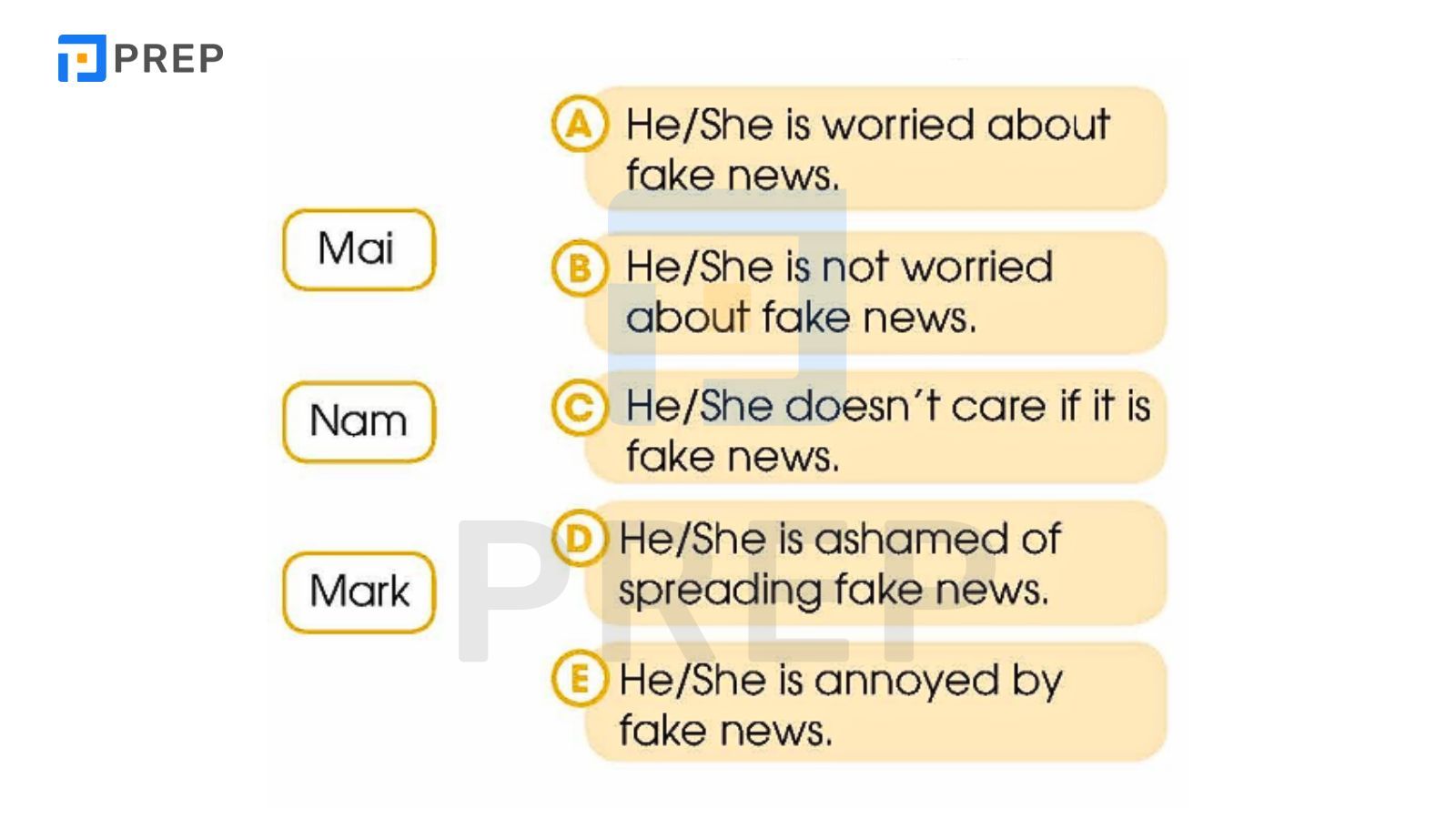
Đáp án:
1. Mai - A. She is worried about fake news.
➨ Giải thích: Mai dùng giọng nghiêm túc (serious tone), gọi fake news là a serious issue, nói: “I'm becoming increasingly concerned…”, “we need to take action” ➨ Rõ ràng lo lắng về fake news.
2. Nam - D. He is ashamed of spreading fake news.
➨ Giải thích: Nam kể chuyện mình chia sẻ tin giả về động đất và người khác cười nhạo hoặc nổi giận. Nam nói: “I wish I had checked all the facts more carefully.” ➨ Cảm thấy hối hận, xấu hổ vì đã lan truyền tin giả.
3. Mark - B. He is not worried about fake news.
➨ Giải thích: Mark nói “So I think there’s nothing to worry about.” ➨ Không lo lắng gì về fake news.
Transcript phần nghe tiếng Anh 12 chương trình mới Unit 7:
Mai (serious tone of voice): Good morning, everyone. Today, Nam, Mark and I are going to talk about fake news. This is a serious issue nowadays as the Internet has become a very popular source of information for everyone around the world. In Viet Nam, there were more than 72 million Internet users in 2022. This accounted for around 75 per cent of the country's population. However, as the Internet is getting more and more popular, I'm becoming increasingly concerned about the rise of fake news published online. Because it's so easy for people to post anything they want on the Internet, false information and fake news stories are very common online. This can be harmful to young people who can be encouraged to believe in dangerous views or actions, and change their behaviour. I think we need to take action and stop the spread of fake news. Do you have anything to add, Nam?
Nam (embarrassing tone of voice): Thank you, Mai. Well, my experience with fake news on the Internet was truly embarrassing. I saw a news story about a powerful earthquake that had injured people and destroyed houses in Central Viet Nam. I immediately shared the story and all the images with my friends and family, and even started planning a charity event. Some people laughed at me, but others were upset and angry with me as they had relatives in Central Viet Nam and were really worried about them. I wish I had checked all the facts more carefully. How about you, Mark? What's your take on fake news?
Mark: Well, I don't think we can stop the spread of fake news, but we should learn to avoid it. First, make sure the websites where the news item or image is published are credible. Such websites usually belong to government organisations or universities, and are updated regularly. Second, look to see if the story appears on other news sites that you know and trust. In addition, pay attention to the language. News stories that are full of spelling and grammar errors, and show bias are very unlikely to be credible and you should avoid using or sharing them. As long as we evaluate everything we read and we're careful about what we share on social media, we can protect ourselves from fake news. So I think there's nothing to worry about.
Bản dịch Transcript:
Mai (giọng nghiêm túc): Chào buổi sáng mọi người. Hôm nay, Nam, Mark và mình sẽ nói về tin giả. Đây là một vấn đề nghiêm trọng hiện nay vì Internet đã trở thành một nguồn thông tin phổ biến trên toàn thế giới.
Tại Việt Nam, năm 2022 có hơn 72 triệu người dùng Internet, chiếm khoảng 75% dân số cả nước. Tuy nhiên, khi Internet ngày càng trở nên phổ biến, mình cũng ngày càng lo ngại về sự gia tăng của các tin giả được đăng tải trên mạng.
Vì việc đăng bất cứ thông tin gì lên Internet quá dễ dàng, nên những thông tin sai lệch và tin giả xuất hiện rất nhiều. Điều này có thể gây hại cho giới trẻ, vì họ có thể bị lôi kéo tin vào những quan điểm hoặc hành vi nguy hiểm, và thay đổi cả hành vi của mình. Mình nghĩ chúng ta cần hành động và ngăn chặn sự lan truyền của tin giả. Nam, bạn có gì muốn chia sẻ thêm không?
Nam (giọng ngượng ngùng): Cảm ơn Mai. Ừm, trải nghiệm của mình với tin giả trên Internet thực sự rất xấu hổ. Mình từng đọc một bài báo nói về một trận động đất mạnh đã khiến nhiều người bị thương và phá hủy nhiều ngôi nhà ở miền Trung Việt Nam. Mình lập tức chia sẻ bài viết cùng hình ảnh đó với bạn bè và gia đình, thậm chí còn bắt đầu lên kế hoạch tổ chức một sự kiện từ thiện. Một số người thì cười mình, nhưng những người khác thì rất lo lắng và giận dữ vì họ có người thân sống ở miền Trung và rất sợ điều tồi tệ đã xảy ra. Giờ mình ước gì lúc đó đã kiểm tra thông tin cẩn thận hơn. Còn bạn thì sao, Mark? Bạn nghĩ gì về tin giả?
Mark: Theo mình thì chúng ta không thể ngăn chặn hoàn toàn việc lan truyền tin giả, nhưng chúng ta nên học cách tránh nó.
Thứ nhất, hãy đảm bảo rằng các trang web nơi tin tức được đăng là đáng tin cậy. Những trang đáng tin thường là của các tổ chức chính phủ hoặc trường đại học, và được cập nhật thường xuyên.
Thứ hai, hãy kiểm tra xem bài viết đó có xuất hiện trên các trang tin tức đáng tin cậy khác hay không.
Ngoài ra, hãy chú ý đến ngôn ngữ được sử dụng – ví dụ như lỗi chính tả, ngữ pháp, và giọng điệu thiên vị – là dấu hiệu cho thấy tin tức đó không đáng tin và bạn nên tránh chia sẻ.
Miễn là chúng ta đánh giá cẩn thận mọi thứ mình đọc và cẩn trọng với những gì mình chia sẻ trên mạng xã hội, thì chúng ta có thể tự bảo vệ mình khỏi tin giả. Vì vậy mình nghĩ không có gì đáng lo lắng cả.
3. Task 3
Listen to the recording again and complete the notes below. Use no more than TWO words and/or numbers for each gap.
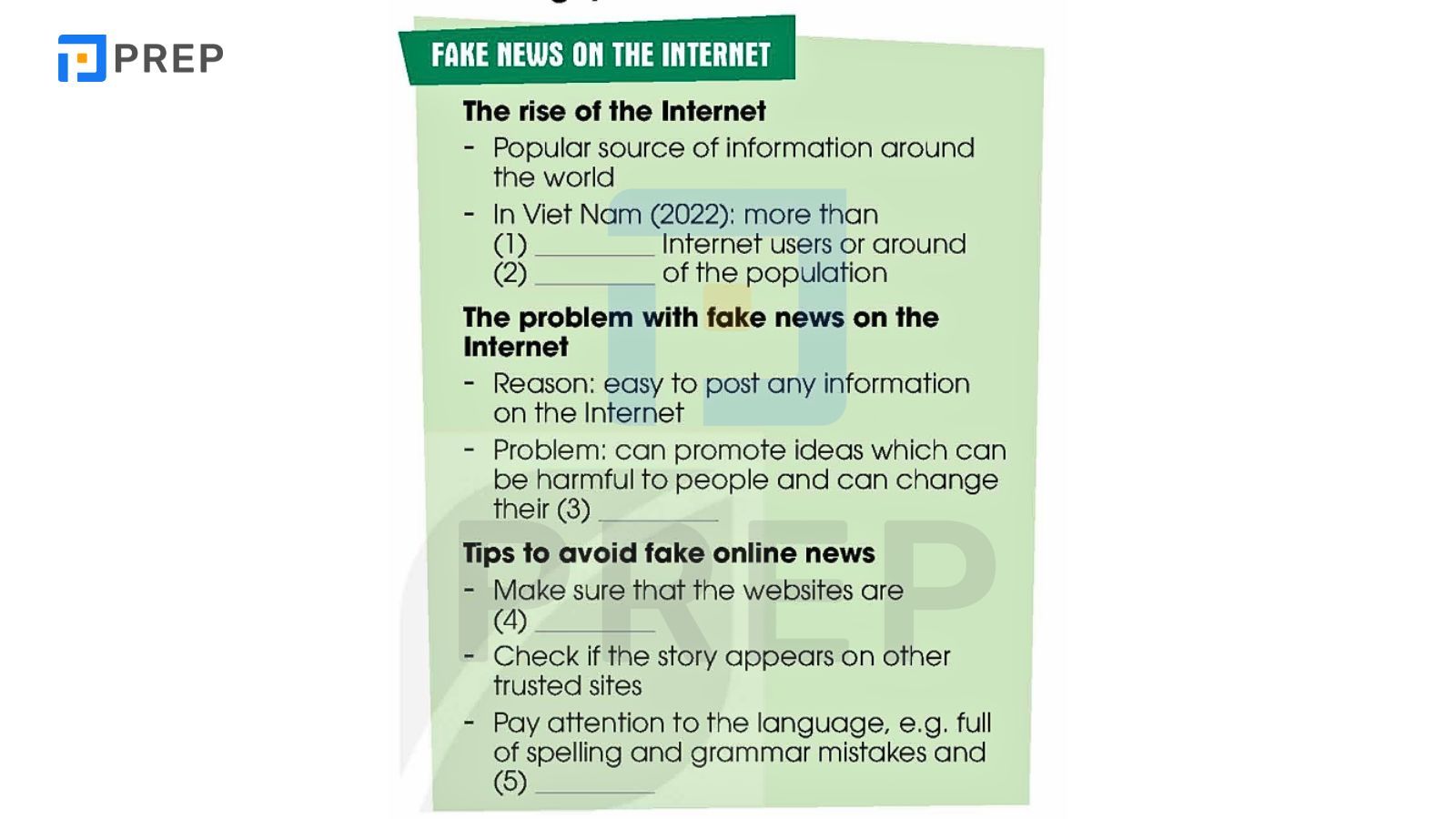
Đáp án:
1. 72 million
2. 75 per cent
3. behaviour
4. credible
5. bias
4. Task 4
Work in groups. Discuss these questions.
How helpful do you find the tips in the talk? Have you used any of them?
Trả lời mẫu:
I find the tips in the talk very helpful because they give clear and practical ways to avoid fake news. For example, I didn’t know that checking the credibility of a website is so important. After listening to the talk, I always check if a news story appears on other trusted sites before believing or sharing it.
I also try to pay attention to the language used in news articles. If I see a lot of spelling and grammar mistakes, or if the article sounds too emotional or biased, I don’t trust it.
So yes, I’ve started using some of these tips, and I think they really help me stay safe online and avoid spreading fake news.
VI. Writing (Trang 96)
Phần Writing của tiếng Anh 12 chương trình mới Unit 7 hướng dẫn học sinh cách viết Pie chart - biểu đồ tròn.
1. Task 1
Work in pairs. Study the pie charts on page 96 and choose the correct answer A or B.
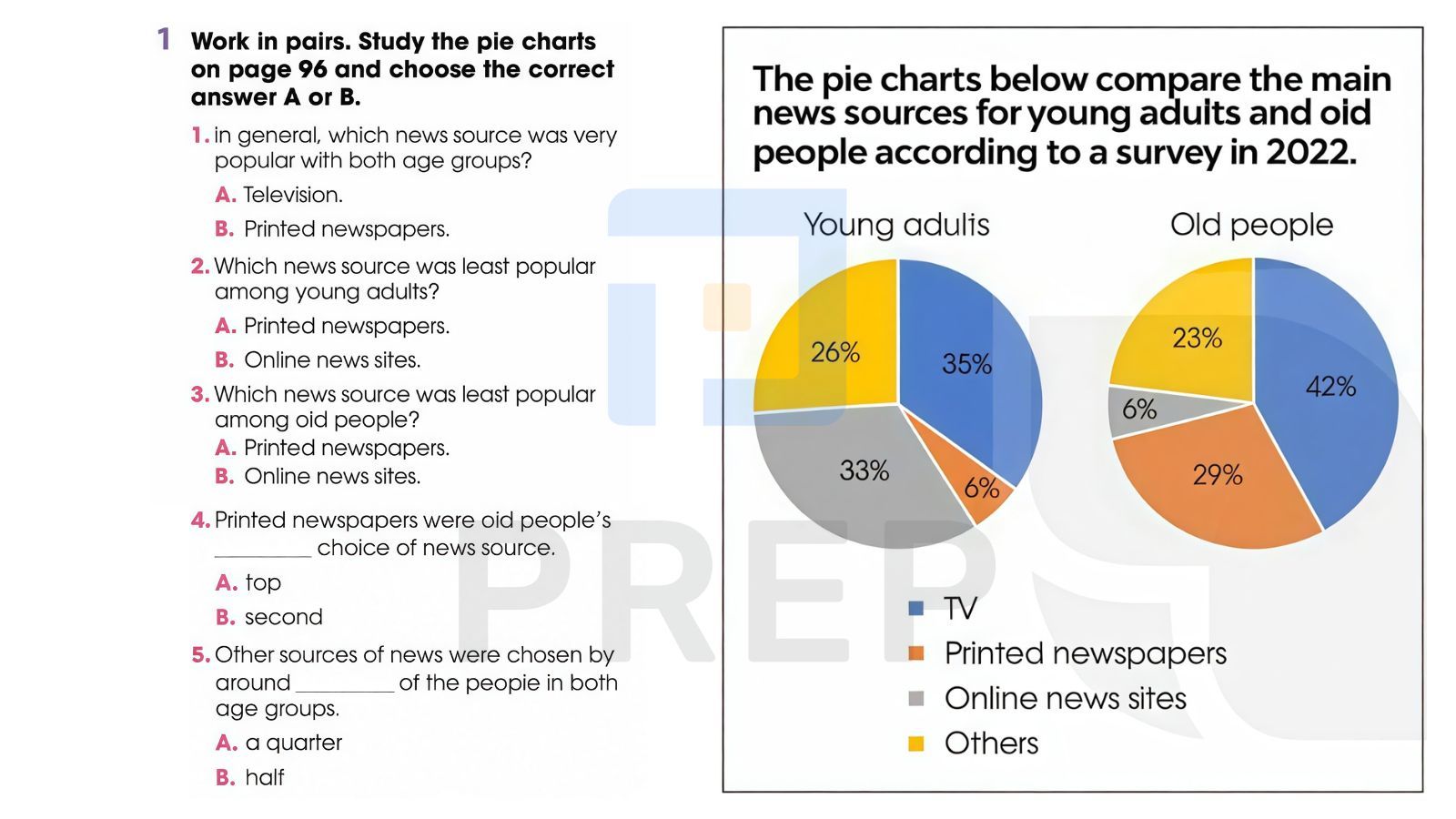
|
Câu |
Đáp án |
Giải thích |
|
1 |
A |
TV (Television): 42% (old) và 35% (young adults) – cao nhất ở cả 2 nhóm |
|
2 |
A |
Printed newspapers – chỉ 6% trong biểu đồ "Young adults" |
|
3 |
B |
Online news sites – chỉ 6% trong biểu đồ "Old people" |
|
4 |
B |
Second – Printed newspapers là lựa chọn thứ hai (29%), sau TV (42%) |
|
5 |
A |
A quarter – 26% (young adults), 23% (old people) ≈ khoảng 1/4 |
2. Task 2
Complete the following descriptions of the charts in 1. Use the words and phrases in the box.
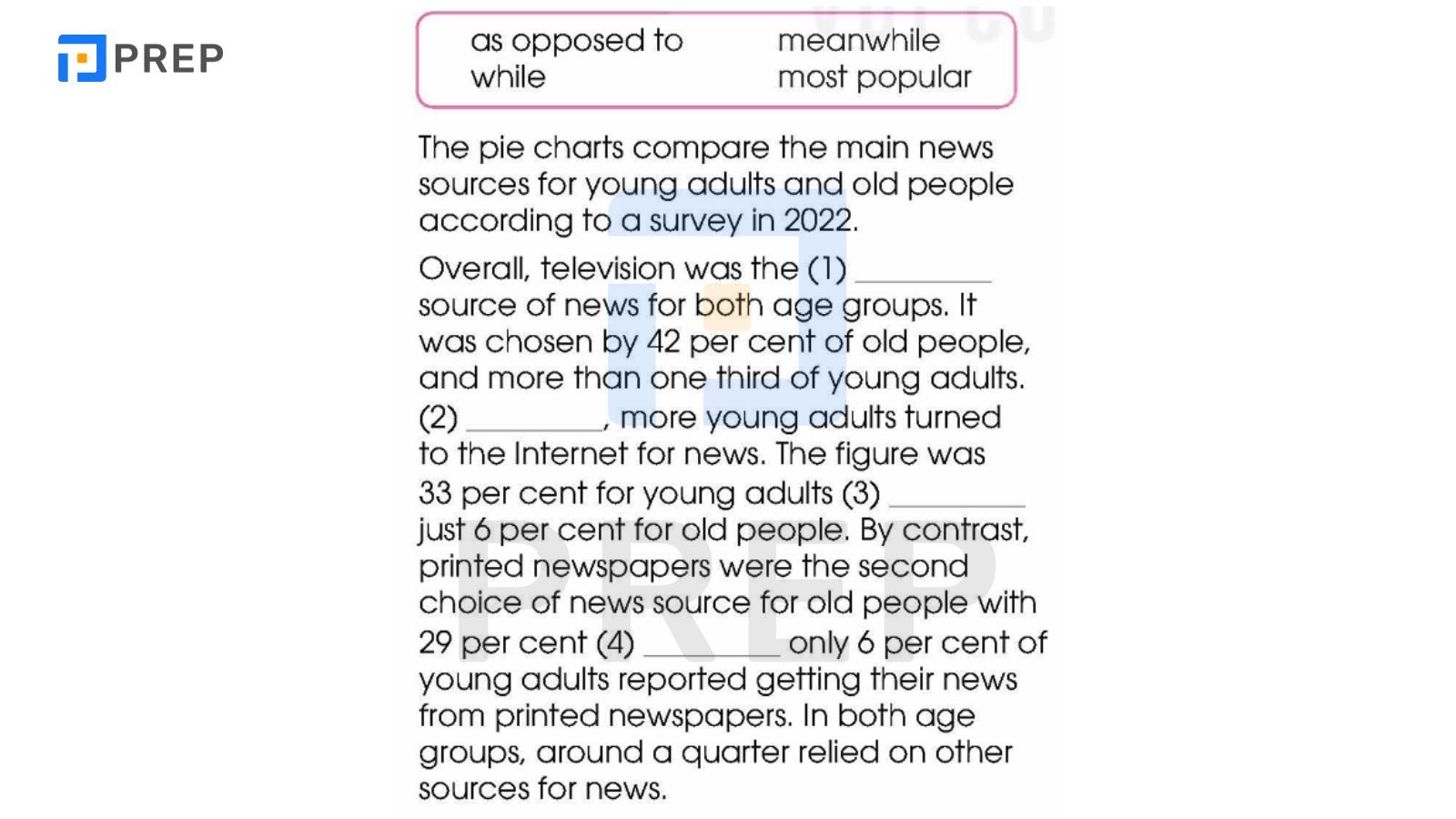
1. most popular
2. Meanwhile
3. as opposed to
4. While
3. Task 3
Write a description (120-150 words) of the charts below. Use the model and tips in 2 to help you.
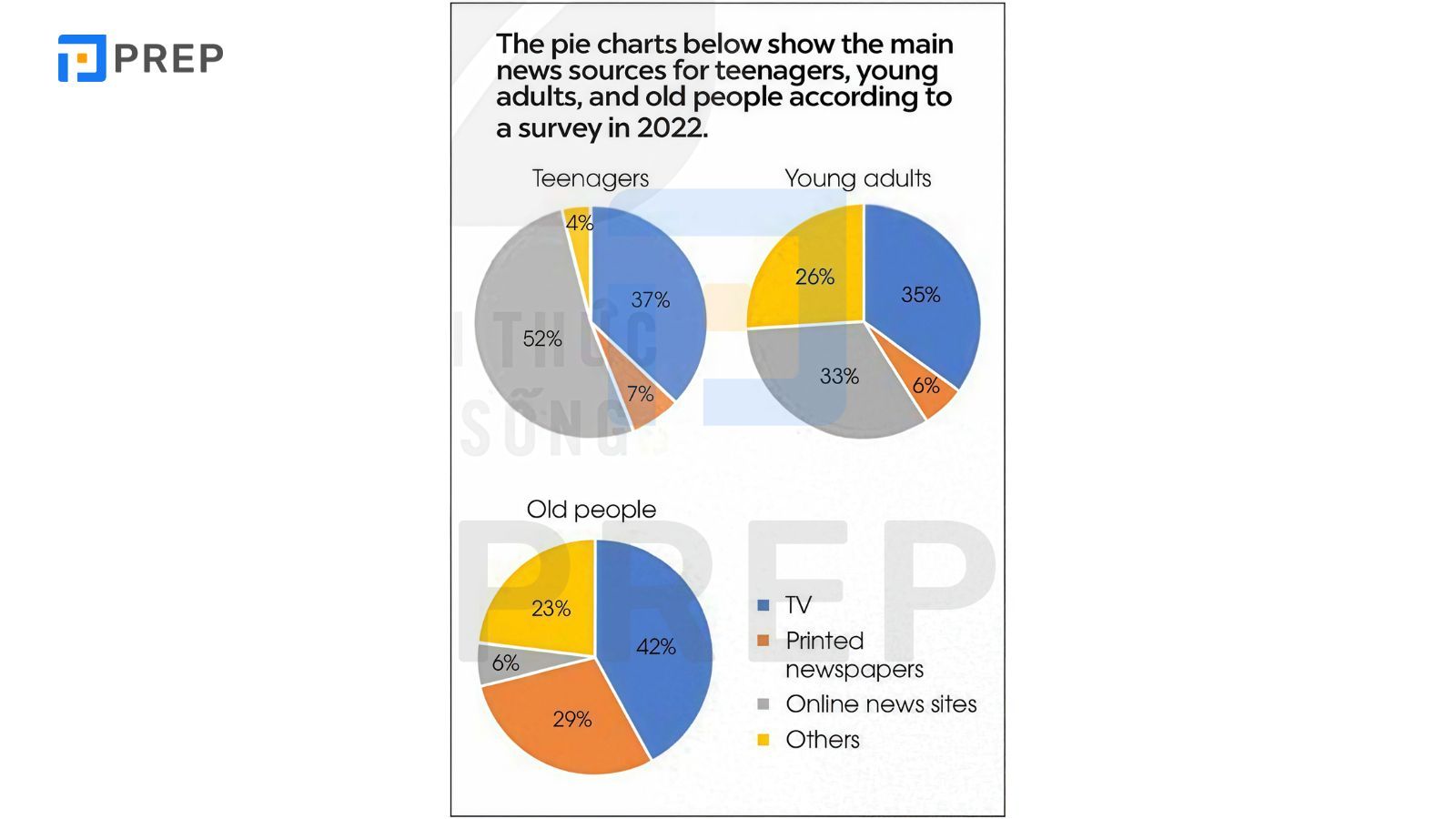
Bài mẫu:
The pie charts illustrate the main news sources for teenagers, young adults, and old people according to a survey in 2022.
Overall, television was the most popular news source for both old people and young adults, while online news sites were the most common choice for teenagers. Among teenagers, more than half (52%) preferred online news sites, followed by 37% who watched TV. Printed newspapers were the least popular (only 7%) for this group. Young adults showed a more balanced distribution, with 35% choosing TV, 33% using online news sites, and 26% using other sources. Only 6% relied on printed newspapers. In contrast, old people mostly preferred traditional media: 42% watched TV, 29% read printed newspapers, and just 6% used online news sites. Other sources accounted for 23%.
Bản dịch:
Biểu đồ tròn minh họa các nguồn tin tức chính được sử dụng bởi thanh thiếu niên, người trưởng thành trẻ và người cao tuổi theo một cuộc khảo sát vào năm 2022.
Nhìn chung, truyền hình là nguồn tin tức phổ biến nhất đối với cả người cao tuổi và người trưởng thành trẻ, trong khi các trang tin tức trực tuyến là lựa chọn phổ biến nhất của thanh thiếu niên. Trong nhóm thanh thiếu niên, hơn một nửa (52%) ưa chuộng các trang tin tức trực tuyến, tiếp theo là 37% chọn xem TV. Báo in là nguồn ít phổ biến nhất (chỉ 7%) trong nhóm này. Những người trưởng thành trẻ có sự phân bố khá đồng đều: 35% chọn TV, 33% sử dụng các trang tin tức trực tuyến và 26% sử dụng các nguồn khác. Chỉ 6% dựa vào báo in. Ngược lại, người cao tuổi chủ yếu thích các phương tiện truyền thông truyền thống: 42% xem TV, 29% đọc báo in và chỉ 6% dùng các trang tin tức trực tuyến. Các nguồn khác chiếm 23%.
VII. Communication and Culture/CLIL (Trang 97 - 98)
Cùng PREP khám phá lời giải phần Communication and Culture/CLIL của Unit 7 tiếng Anh 12 sau đây nhé!
1. Everyday English
1.1. Task 1
Listen and complete the conversations with the expressions in the box. Then practise them in pairs.
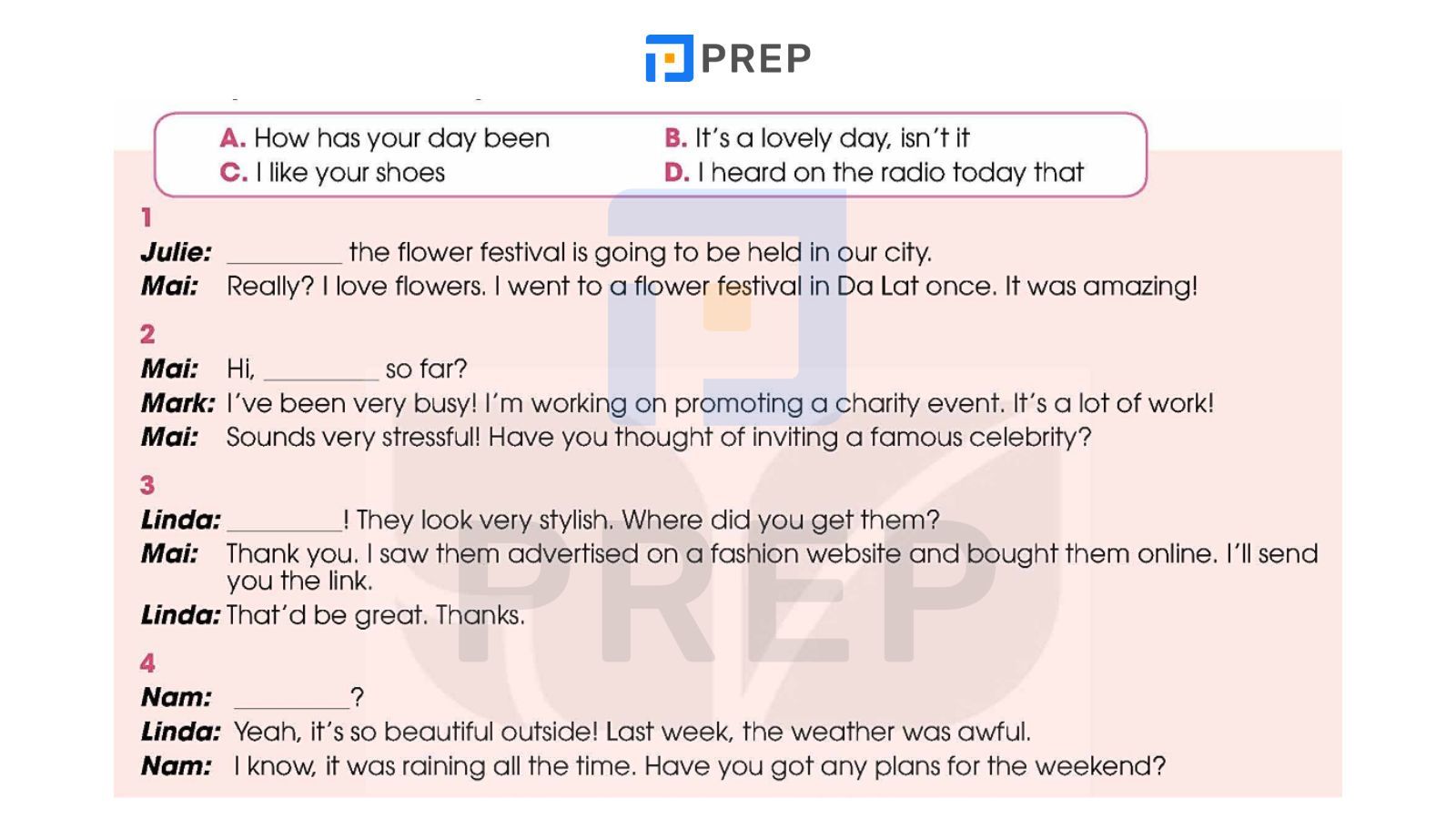
Đáp án: 1. D 2. A 3. C 4. B
1.2. Task 2
Work in pairs. Use the models in 1 to make similar conversations for these situations. One of you is A, the other is B. Use the tips and expressions below to help you.
Tình huống 1: A và B không quen nhau, gặp nhau tại tiệc sinh nhật của một người bạn chung. A bắt chuyện, nói chuyện xã giao và phát hiện cả hai đều hứng thú với ngành truyền thông.
Hội thoại mẫu:
A: Hi, I don’t think we’ve met before. I’m Anna.
B: Nice to meet you, Anna. I’m Minh.
A: How has your day been?
B: It’s been great, thanks. The party is fun!
A: Yes, it’s a lovely evening. I heard you’re interested in the media industry?
B: Yeah! I want to be a journalist. What about you?
A: Same here! I’m really into media production.
B: That’s cool! Maybe we can work on something together in the future.
A: That’d be great. I’d love that!
Tình huống 2: A và B đều là thành viên của CLB Truyền thông trường. Không quá thân thiết, nhưng tình cờ gặp nhau ở công viên. B bắt chuyện và cả hai phát hiện họ đều đang phụ trách tổ chức một sự kiện của trường.
Hội thoại mẫu:
B: Hi, how has your day been?
A: Pretty good, thanks. Just enjoying a walk.
B: It’s a lovely day, isn’t it?
A: Absolutely! Such a nice break from all the planning for the school event.
B: Wait, are you also in charge of the media event next month?
A: Yes! I’m coordinating the promotion part. What about you?
B: Same here. I’m working on the poster designs and social media updates.
A: Wow, looks like we’ll be working together a lot!
B: Definitely. Let’s exchange contacts so we can keep in touch.
2. Culture
2.1. Task 1
Read the following text and complete the table below.
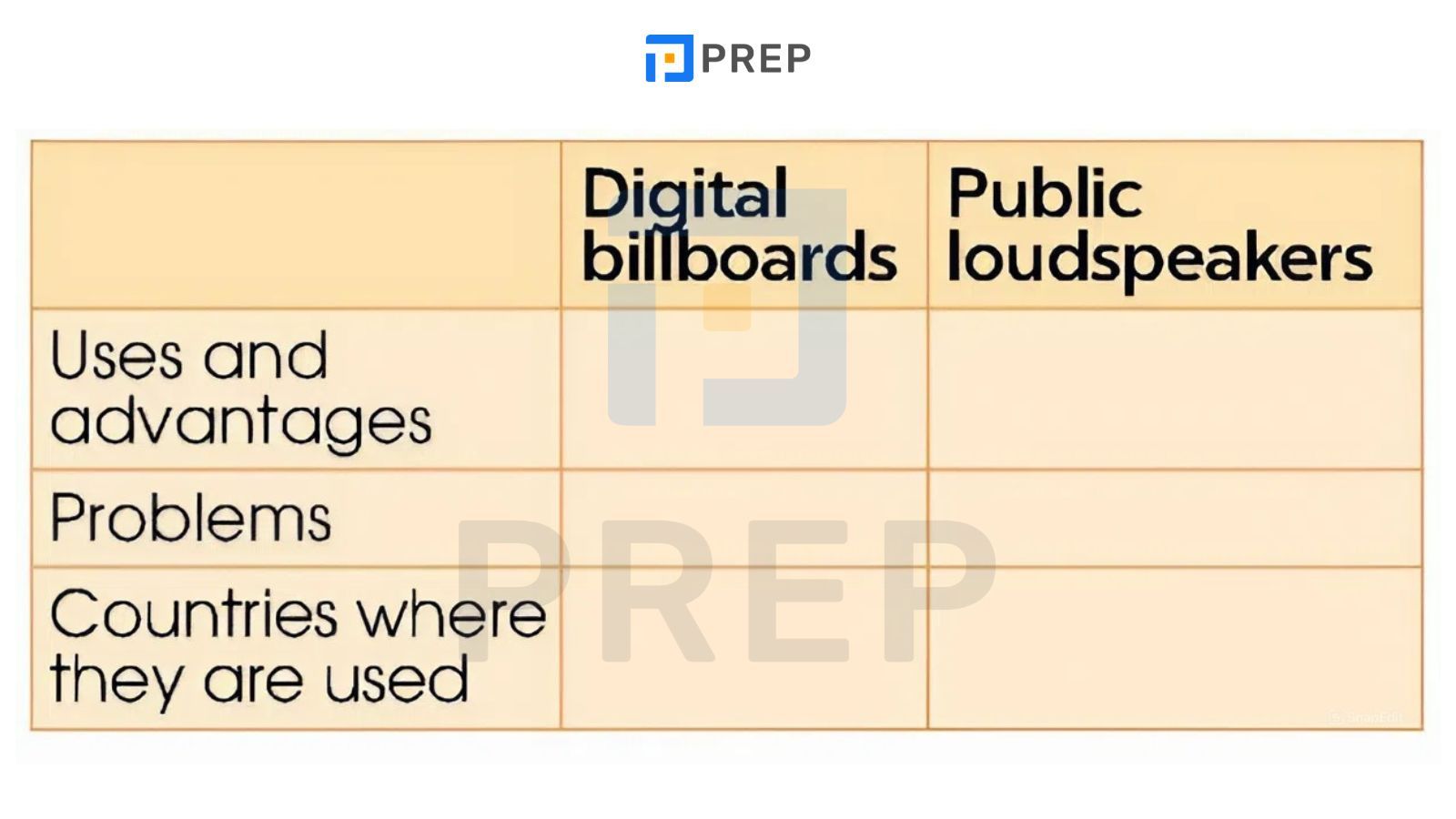
|
Digital billboards |
Public loudspeakers |
|
|
Uses and advantages |
|
|
|
Problems |
|
|
|
Countries where they are used |
|
|
Bản dịch:
PHƯƠNG TIỆN TRUYỀN THÔNG ĐẠI CHÚNG TRÊN TOÀN THẾ GIỚI
Có nhiều loại phương tiện truyền thông đại chúng khác nhau và một số loại hoạt động hiệu quả hơn những loại khác trong từng tình huống cụ thể. Chúng có thể hiện đại như bảng quảng cáo kỹ thuật số, hoặc đơn giản như loa phát thanh công cộng.
Bảng quảng cáo kỹ thuật số
Không giống như bảng quảng cáo truyền thống chỉ hiển thị được một hình ảnh in cố định, bảng quảng cáo kỹ thuật số có thể thay đổi giữa nhiều thông điệp khác nhau. Bảng quảng cáo kỹ thuật số cũng được cho là thu hút hơn bảng truyền thống, và mọi người thường chú ý đến chúng hơn. Hơn nữa, chúng còn có thể được cập nhật theo thời gian thực.
Ngày nay, bảng quảng cáo kỹ thuật số phổ biến ở nhiều thành phố lớn trên thế giới. Thật khó để tưởng tượng những nơi như Quảng trường Thời đại ở New York, Quảng trường Piccadilly ở London hay khu Shibuya ở Tokyo mà không có các biển quảng cáo sáng rực.
Mặc dù ngày càng được ưa chuộng, nhưng vẫn có những lo ngại về tác động của chúng đến môi trường xung quanh. Ô nhiễm ánh sáng toàn cầu đang gia tăng mỗi năm. Ánh sáng liên tục phát ra từ bảng quảng cáo kỹ thuật số thường khiến chim bị rối loạn định hướng, gây hại cho côn trùng và cũng có thể ảnh hưởng đến sức khỏe con người.
Loa phát thanh công cộng
Trước đây, loa phát thanh công cộng được sử dụng trong thời chiến để cảnh báo người dân về các cuộc không kích. Ngày nay, chúng vẫn còn được dùng ở một số khu vực tại Nhật Bản, Philippines và Hoa Kỳ để cảnh báo người dân về thiên tai như bão, động đất và lốc xoáy.
Tại Việt Nam, loa phát thanh được sử dụng để truyền đạt các thông báo quan trọng đến người dân địa phương. Tuy nhiên, tiếng ồn từ hệ thống loa phát thanh trên toàn thành phố có thể gây phiền toái đối với một số người.
2.2. Task 2
Work in pairs. Discuss the questions.
How effective do you think these types of mass media are? Will they become more or less popular in the future? Why/Why not?
Trả lời mẫu:
I think digital billboards are very effective because they can display eye-catching, dynamic content and can be updated in real time. They are widely used in big cities and easily attract people’s attention. I believe they will become more popular in the future as technology improves and more businesses want modern advertising solutions. However, their environmental impact, such as light pollution, might lead to more strict regulations in some countries.
On the other hand, public loudspeakers are useful in emergencies, especially in areas where people don’t have access to phones or the Internet. They can quickly deliver messages to large numbers of people. But I think they will become less popular over time because people now rely more on smartphones, social media, and emergency alert apps. In urban areas, loudspeakers are also seen as noisy and outdated.
VIII. Looking back (Trang 99)
Phần Looking Back của Unit 7 lớp 12 tổng hợp toàn bộ kiến thức đã học thông qua các bài tập ôn tập phát âm, từ vựng và ngữ pháp.
1. Pronunciation
Work in pairs and mark (ᴗ) the places where the linking /r/ can appear. Listen and check. Then practise saying the sentences.
1. Peter‿and I are discussing the news in the local press.
2. There‿is a huge poster‿on the wall advertising the public event.
3. The village is far‿away in the mountains, but the villagers have a fast Internet connection.
4. The singer‿is the focus of media attention.
2. Vocabulary
Solve the crossword with the words you've learnt in this unit. What is the hidden word?
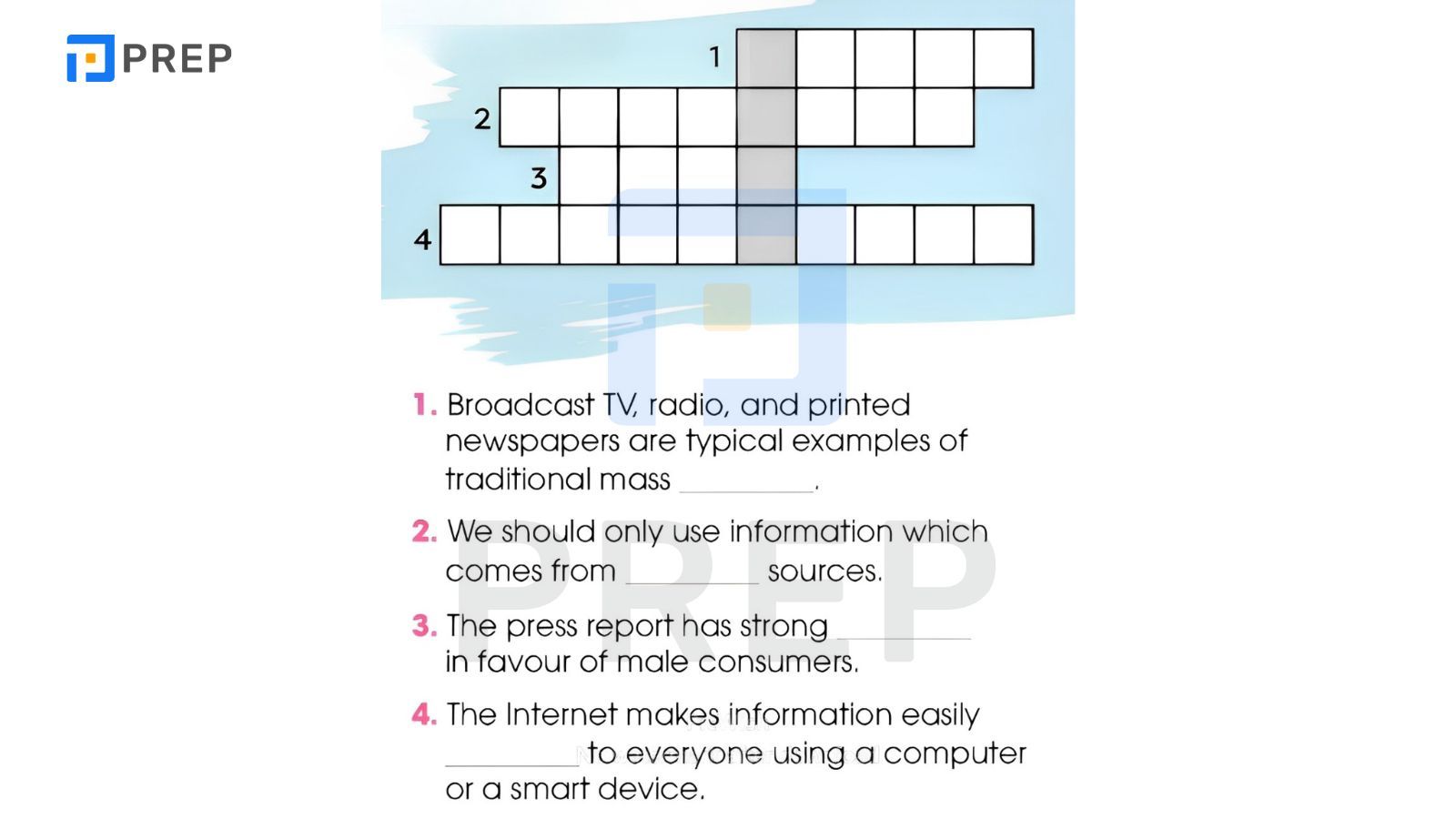
1. Media
2. Reliable
3. Bias
4. Accessible
➨ Hidden word: Mass
3. Grammar
Circle the mistake in each sentence. Then correct it.
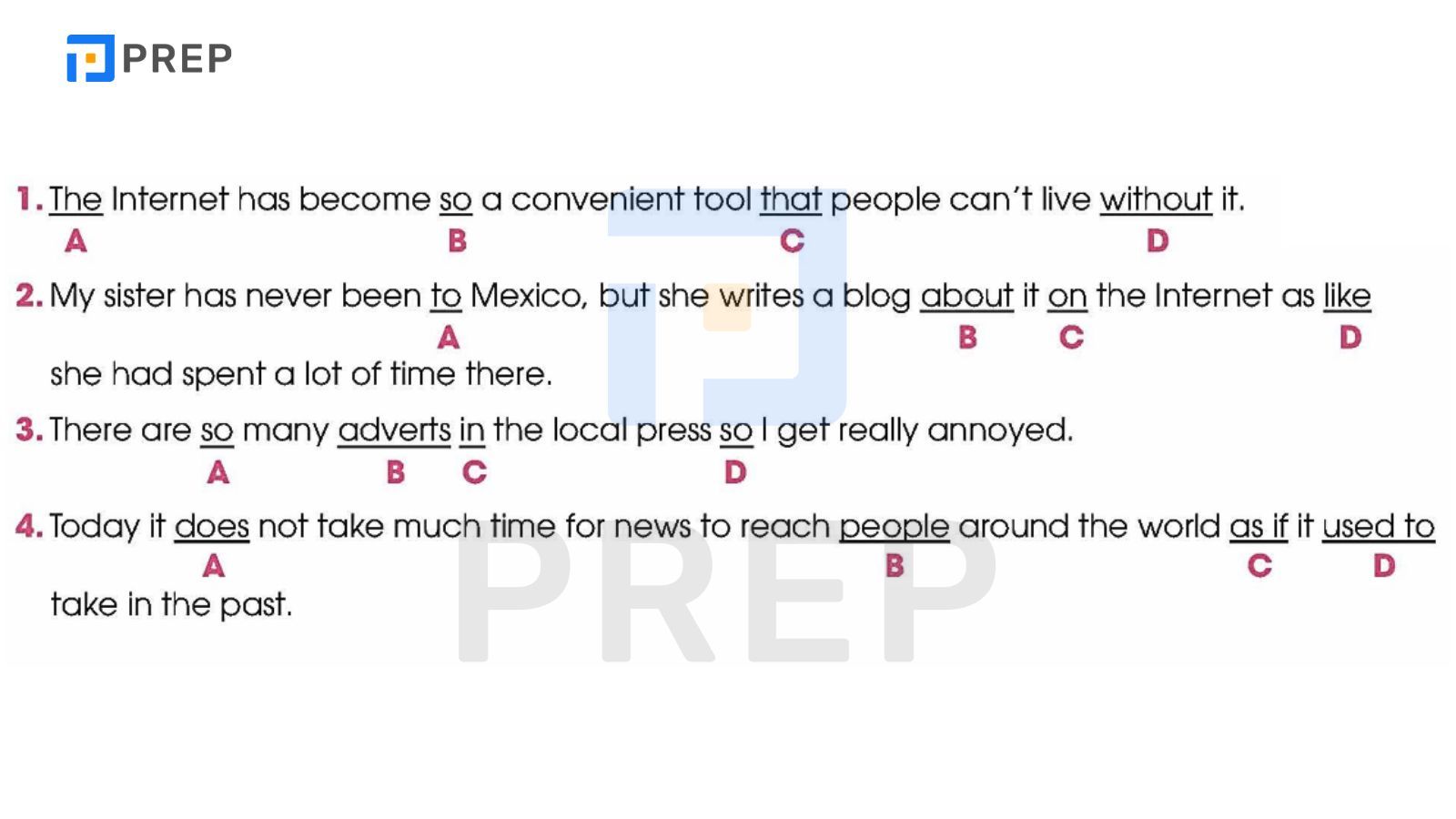
1. B. so ➨ such
➨ Giải thích: “So” không được dùng trước a + tính từ + danh từ. Cấu trúc đúng là “such a + adj + noun”.
2. D. like ➨ if
➨ Giải thích: Không được dùng “as like”. Bạn phải chọn “as if” hoặc “like” (chỉ dùng một trong hai, không phải cả hai).
3. D. so ➨ that
➨ Giải thích: Sử dụng cấu trúc “so many... that...”.
4. C. as if ➨ as
➨ Giải thích: Cụm "as if" mang nghĩa là "như thể", dùng để mô tả một điều không có thật hoặc trái với sự thật. Thay vào đó, ta sử dụng as có nghĩa là như (đã từng xảy ra).
Tham khảo thêm lời giải cho các Unit khác trong tiếng Anh 12 SGK Global Success:
IX. Từ vựng tiếng Anh 12 Unit 7
Việc nắm vững từ vựng chuyên ngành về truyền thông đại chúng là nền tảng quan trọng giúp học sinh hiểu sâu nội dung Unit 7 lớp 12. Phần từ vựng này bao gồm 66 từ và cụm từ thiết yếu, bao gồm các nhóm chủ đề khác nhau từ các phương tiện truyền thông truyền thống đến các nền tảng kỹ thuật số hiện đại. Để tối ưu hóa quá trình ghi nhớ, các bạn nên tạo sơ đồ tư duy kết nối các từ vựng theo ngữ cảnh sử dụng thực tế.
|
Từ vựng |
Phiên âm |
Nghĩa tiếng Việt |
Ví dụ |
|
1. accessible (adj) |
/əkˈsesəbl/ |
có thể tiếp cận, truy cập được |
Digital media is easily accessible on our smartphones and laptops. |
|
2. account for (phr. v) |
/əˈkaʊnt fɔː(r)/ |
chiếm (tỉ lệ), giải thích cho |
Online news sites accounted for 33% of the sources for young adults. |
|
3. advert (n) |
/ˈædvɜːt/ |
(mẩu) quảng cáo |
I saw an interesting advert for a charity event in the local newspaper. |
|
4. advertise (v) |
/ˈædvətaɪz/ |
quảng cáo |
Many companies now advertise their products heavily on social media. |
|
5. as if / as though |
/əz ɪf/ /əz ðəʊ/ |
như thể là |
He talks about media trends as if he were an expert. |
|
6. audience (n) |
/ˈɔːdiəns/ |
khán giả, công chúng |
Television can reach a very large audience across the country. |
|
7. bias (n) |
/ˈbaɪəs/ |
sự thiên vị, thành kiến |
Some newspapers may show a political bias in their reporting. |
|
8. billboard (n) |
/ˈbɪlbɔːd/ |
biển quảng cáo |
Digital billboards in Times Square are famous worldwide. |
|
9. broadcast (v) |
/ˈbrɔːdkɑːst/ |
phát sóng |
The event will be broadcast live on the national TV channel. |
|
10. by contrast |
/baɪ ˈkɒntrɑːst/ |
trái lại, ngược lại |
Young adults love online news. By contrast, old people prefer newspapers. |
|
11. censorship (n) |
/ˈsensəʃɪp/ |
cơ quan kiểm duyệt |
Censorship ensures that inappropriate content is not broadcast. |
|
12. charity (n) |
/ˈtʃærəti/ |
từ thiện |
The school charity club is planning a music show. |
|
13. communication (n) |
/kəˌmjuːnɪˈkeɪʃn/ |
sự giao tiếp, truyền thông |
Social media is a popular tool of communication nowadays. |
|
14. compare (v) |
/kəmˈpeə(r)/ |
so sánh |
The pie charts compare the main news sources for two age groups. |
|
15. confusing (adj) |
/kənˈfjuːzɪŋ/ |
gây bối rối, khó hiểu |
The amount of information online can be very confusing. |
|
16. content (n) |
/ˈkɒntent/ |
nội dung |
The cost of creating high-quality content for television is very high. |
|
17. credible (adj) |
/ˈkredəbl/ |
đáng tin cậy |
Traditional media offers information from sources that are fact-checked and credible. |
|
18. cyberbullying (n) |
/ˈsaɪbəbʊliɪŋ/ |
bắt nạt trên mạng |
We need to raise awareness of cyberbullying among teenagers. |
|
19. debate (n) |
/dɪˈbeɪt/ |
cuộc tranh luận |
Welcome to our Debate Corner on digital vs. traditional media. |
|
20. description (n) |
/dɪˈskrɪpʃn/ |
sự mô tả |
Write a description of the pie charts below. |
|
21. digital (adj) |
/ˈdɪdʒɪtl/ |
thuộc về kỹ thuật số |
Digital media includes websites, social media, and online videos. |
|
22. disadvantaged (adj) |
/ˌdɪsədˈvɑːntɪdʒd/ |
có hoàn cảnh khó khăn |
The campaign aims to help disadvantaged children. |
|
23. discussion (n) |
/dɪˈskʌʃn/ |
cuộc thảo luận |
We had a long discussion about the pros and cons of social media. |
|
24. distribute (v) |
/dɪˈstrɪbjuːt/ |
phân phát, lan truyền |
Digital media is any form of media that is created and distributed via electronic devices. |
|
25. dominant (adj) |
/ˈdɒmɪnənt/ |
chiếm ưu thế, thống trị |
TV was the most dominant news source for both age groups. |
|
26. drama (n) |
/ˈdrɑːmə/ |
kịch, tuồng |
I prefer watching a historical drama to reading a newspaper. |
|
27. easily (adv) |
/ˈiːzəli/ |
một cách dễ dàng |
Digital media content can be updated easily and frequently. |
|
28. electronic device (n.p) |
/ɪˌlekˈtrɒnɪk dɪˈvaɪs/ |
thiết bị điện tử |
We access digital media through various electronic devices. |
|
29. email (n) |
/ˈiːmeɪl/ |
thư điện tử |
Sending a promotional email is a low-cost way to reach people. |
|
30. encourage (v) |
/ɪnˈkʌrɪdʒ/ |
khuyến khích, động viên |
My friends encouraged me to start my own blog. |
|
31. event (n) |
/ɪˈvent/ |
sự kiện |
The club is planning a big charity event next month. |
|
32. fact-check (v) |
/ˈfækt tʃek/ |
kiểm chứng thông tin |
Always fact-check information before you share it online. |
|
33. fake news (n.p) |
/feɪk njuːz/ |
tin tức giả |
The internet has a problem with the spread of fake news. |
|
34. flexible (adj) |
/ˈfleksəbl/ |
linh hoạt |
Online learning is more flexible than traditional classes. |
|
35. frequently (adv) |
/ˈfriːkwəntli/ |
một cách thường xuyên |
The website is updated frequently throughout the day. |
|
36. harm (v) |
/hɑːm/ |
gây hại |
Fake news can harm people's reputations. |
|
37. headline (n) |
/ˈhedlaɪn/ |
tiêu đề (báo) |
A catchy headline can attract more readers. |
|
38. infographic (n) |
/ˌɪnfəʊˈɡræfɪk/ |
đồ họa thông tin |
An infographic can present complex data in an easy-to-understand way. |
|
39. instantly (adv) |
/ˈɪnstəntli/ |
ngay lập tức |
With digital media, information can be shared instantly. |
|
40. interactive (adj) |
/ˌɪntərˈæktɪv/ |
có tính tương tác |
In addition, digital media forms are more interactive. |
|
41. leaflet (n) |
/ˈliːflət/ |
tờ rơi |
We can distribute leaflets to inform people about the event. |
|
42. magazine (n) |
/ˌmæɡəˈziːn/ |
tạp chí |
She enjoys reading fashion magazines in her free time. |
|
43. mass media (n.p) |
/ˌmæs ˈmiːdiə/ |
truyền thông đại chúng |
The mass media plays a crucial role in shaping public opinion. |
|
44. media (n) |
/ˈmiːdiə/ |
phương tiện truyền thông |
Digital media is becoming more popular than traditional media. |
|
45. newspaper (n) |
/ˈnjuːzpeɪpə(r)/ |
báo giấy |
My grandfather reads the newspaper every morning. |
|
46. notice (v) |
/ˈnəʊtɪs/ |
chú ý, để ý |
People may not notice our poster among many others. |
|
47. opinion (n) |
/əˈpɪnjən/ |
ý kiến, quan điểm |
In my opinion, traditional media is more credible. |
|
48. powerful (adj) |
/ˈpaʊəfl/ |
mạnh mẽ, có sức ảnh hưởng |
The internet is such a powerful tool for communication. |
|
49. presentation (n) |
/ˌpreznˈteɪʃn/ |
bài thuyết trình |
His presentation on the history of media was very informative. |
|
50. printed (adj) |
/ˈprɪntɪd/ |
được in ra |
Printed newspapers have a smaller audience now. |
|
51. profit-making (adj) |
/ˈprɒfɪt meɪkɪŋ/ |
tạo ra lợi nhuận |
It's a charity event, not a profit-making one. |
|
52. promote (v) |
/prəˈməʊt/ |
quảng bá, thúc đẩy |
We need to find the best way to promote the music show. |
|
53. proportion (n) |
/prəˈpɔːʃn/ |
tỉ lệ, phần |
The largest proportion of old people get their news from TV. |
|
54. public (n) |
/ˈpʌblɪk/ |
công chúng |
The event is open to the public. |
|
55. publicity (n) |
/pʌbˈlɪsəti/ |
sự công khai, quảng bá |
I'm in charge of the publicity for the event. |
|
56. radio (n) |
/ˈreɪdiəʊ/ |
đài phát thanh |
Listening to the radio is a good way to practice listening skills. |
|
57. reliable (adj) |
/rɪˈlaɪəbl/ |
đáng tin cậy |
Is information on social media always reliable? |
|
58. social media (n.p) |
/ˌsəʊʃl ˈmiːdiə/ |
truyền thông xã hội |
Social media has changed the way we communicate. |
|
59. source (n) |
/sɔːs/ |
nguồn (tin tức) |
You should always check the source of the information. |
|
60. stressed (adj) |
/strest/ |
căng thẳng, bị áp lực |
I'm so stressed about organizing this event. |
|
61. survey (n) |
/ˈsɜːveɪ/ |
cuộc khảo sát |
A recent survey shows a decline in newspaper readership. |
|
62. television (n) |
/ˈtelɪvɪʒn/ |
truyền hình |
Television remains a dominant source of news for many people. |
|
63. traditional (adj) |
/trəˈdɪʃənl/ |
truyền thống |
Traditional media includes newspapers, TV, and radio. |
|
64. trust (v) |
/trʌst/ |
tin tưởng |
It's hard to know which sources to trust online. |
|
65. update (v) |
/ʌpˈdeɪt/ |
cập nhật |
The news website is updated every hour. |
|
66. viewer (n) |
/ˈvjuːə(r)/ |
người xem (truyền hình) |
TV viewers today have access to hundreds of channels. |
Qua Tiếng Anh 12 Unit 7 "The World of Mass Media", bạn đã được trang bị một bộ công cụ ngôn ngữ và tư duy toàn diện để phân tích thế giới truyền thông phức tạp. Việc hiểu rõ ưu và nhược điểm của từng loại hình media, cũng như nhận biết được tin tức giả, là một kỹ năng sống còn trong thế kỷ 21. Hãy tiếp tục luyện tập để sử dụng kiến thức này một cách thành thạo, trở thành một công dân toàn cầu thông thái và có trách nhiệm. Chúc bạn học tốt!
PREP mang đến giải pháp học tiếng Anh online hiệu quả với AI độc quyền. Bạn có thể tự học tại nhà với các khóa học IELTS, TOEIC, VSTEP, APTIS và tiếng Anh giao tiếp. Teacher Bee AI sẽ hỗ trợ bạn suốt quá trình học, giúp bạn nhanh chóng nâng cao kỹ năng ngôn ngữ.
Liên hệ HOTLINE 0931428899 hoặc click TẠI ĐÂY để được tư vấn chi tiết!
Tải app PREP ngay hôm nay để bắt đầu học tiếng Anh online chất lượng cao tại nhà.

Chào bạn! Mình là Hiền Hoàng, hiện đang đảm nhận vai trò quản trị nội dung sản phẩm tại Blog của website prepedu.com.
Với hơn 5 năm tự học các ngoại ngữ như tiếng Anh, tiếng Trung và ôn luyện một số kỳ thi IELTS, TOEIC, HSK, mình đã tự đúc rút được nhiều kinh nghiệm để hỗ trợ hàng nghìn người đang gặp khó khăn trong việc học ngoại ngữ. Hy vọng rằng những chia sẻ phía trên sẽ giúp ích cho bạn trong quá trình tự ôn luyện thi hiệu quả tại nhà!
Bình luận
Nội dung premium
Xem tất cảLộ trình cá nhân hoá
Có thể bạn quan tâm
Kết nối với Prep

MSDN: 0109817671.
Địa chỉ liên hệ: Tòa nhà Vinaconex, 34 Láng Hạ, phường Láng, TP Hà Nội.
Trung tâm CSKH tại HN: Lô 21 C2 Khu đô thị Nam Trung Yên, phường Yên Hòa, TP Hà Nội.
Trung tâm CSKH tại HCM: 288 Pasteur, Phường Xuân Hòa, TP Hồ Chí Minh
Trụ sở Công ty: Số nhà 20, ngách 234/35 đường Hoàng Quốc Việt, phường Nghĩa Đô, TP Hà Nội.
Phòng luyện ảo - Trải nghiệm thực tế - Công nghệ hàng đầu.
Hotline: 0931 42 8899.
Trụ sở Công ty: Số nhà 20, ngách 234/35 đường Hoàng Quốc Việt, phường Nghĩa Đô, TP Hà Nội.
Giấy chứng nhận hoạt động đào tạo, bồi dưỡng số 1309/QĐ-SGDĐT ngày 31 tháng 07 năm 2023 do Sở Giáo dục và Đào tạo Hà Nội cấp.
